If you’re looking for a way to preserve your food for longer periods, dehydrating it is an excellent option. Dehydrated food is not only convenient but also nutritious and delicious. Learn how to properly store your dehydrated food and extend its shelf life with our comprehensive guide. Don’t let your dehydrated food go to waste! From vacuum sealing to O2 absorbers, our expert storage tips will keep your snacks tasting great.
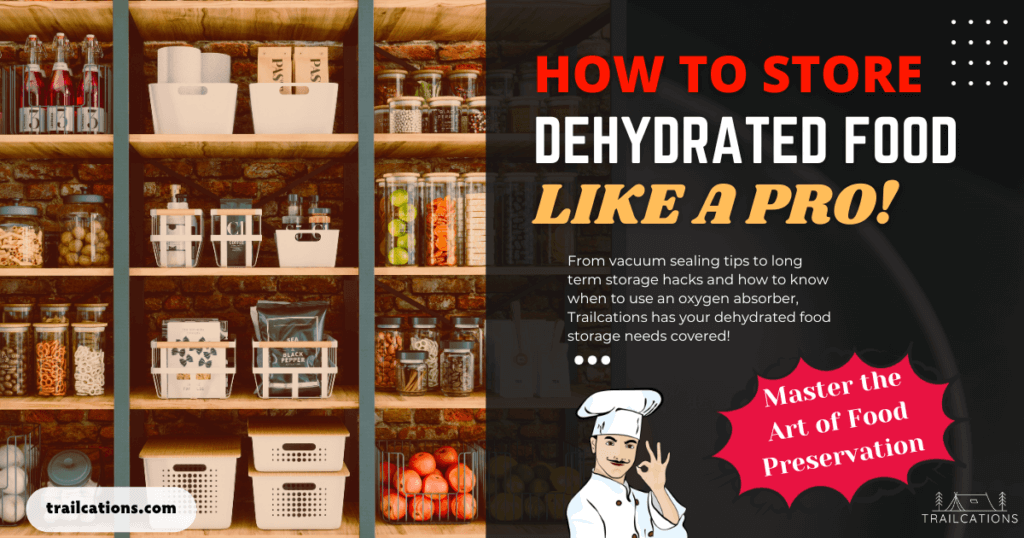
One of the best ways to store dehydrated food is by using airtight containers such as mason jars or vacuum-sealed bags. These containers keep the food fresh by preventing moisture and air from getting in. You should also store your dehydrated food in a cool, dry place away from sunlight.
Another important factor to consider when storing dehydrated food is the size of the container. It’s best to use containers that match the size of the food to minimize the amount of air inside. This helps to prevent spoilage and maintain the quality of the food. Additionally, you should avoid opening the container frequently as this exposes the food to moisture and air.
Table of Contents
- Why Store Dehydrated Foods?
- Factors to Consider When Storing Dehydrated Foods
- Storage Containers and Methods for Storing Dehydrated Food
- How Do You Know If Your Dehydrated Food is Dry Enough?
- 7 Expert Tips on How to Package Dehydrated Food
- What is the Best Way to Store Dehydrated Food?
- What is the Best Storage Bag for Dehydrated Food?
- What is the Best Jar to Store Dehydrated Food in?
- Where Should Dehydrated Food Be Stored?
- What is the Shelf Life of Homemade Dehydrated Food?
- How to Store Dehydrated Food for Long Term?
- Pretreatment for Longest Dehydrated Food Shelf Life
- Conditioning Foods: Don’t Skip This Step!
- How To Vacuum Seal Dehydrated Food?
- Oxygen Absorbers vs. Desiccant Packs (Silica Gel / Silica Bead Packets)
- How Do You Keep Dehydrated Food Dry?
- Can Food Spoil While Dehydrating?
- What Foods Can Be Dehydrated for Long Term Storage?
- What Dried Food Lasts the Longest
- FAQs
Why Store Dehydrated Foods?
If you’re looking for a way to extend the shelf life of your food, dehydrating is an excellent option. Not only does it help preserve your food, but it also provides several other benefits that make it a popular choice for many people.
Whether you’re planning a camping trip, trying to reduce food waste or growing your emergency food storage pantry, dehydrating is an excellent food preservation process. In this section, we’ll take a look at some of the reasons why you should consider storing dehydrated foods.

Benefits of Dehydrated Foods
Dehydrated foods are a great option for those who want to eat healthy and nutritious food. Dehydrated foods retain 97% (1) of their nutritional value and are a great source of vitamins, minerals, and fiber. Learn just how healthy dehydrated food is in our deep dive into the Nutritional Content of Dehydrated Food.
Another benefit of dehydrated foods is that they are lightweight and easy to store. Unlike fresh foods, which can spoil quickly, dehydrated foods can last for months or even years if stored properly. This makes them an excellent option for those who want to stock up on food for emergencies or for those who want to save money by buying in bulk.
Dehydrating your own food helps you avoid excess preservatives found in commercially dried food. It can also save you money and reduce food waste. We love dehydrating food so much that we wrote an article on 49 Amazing Benefits of Dehydrating Food to inspire you.
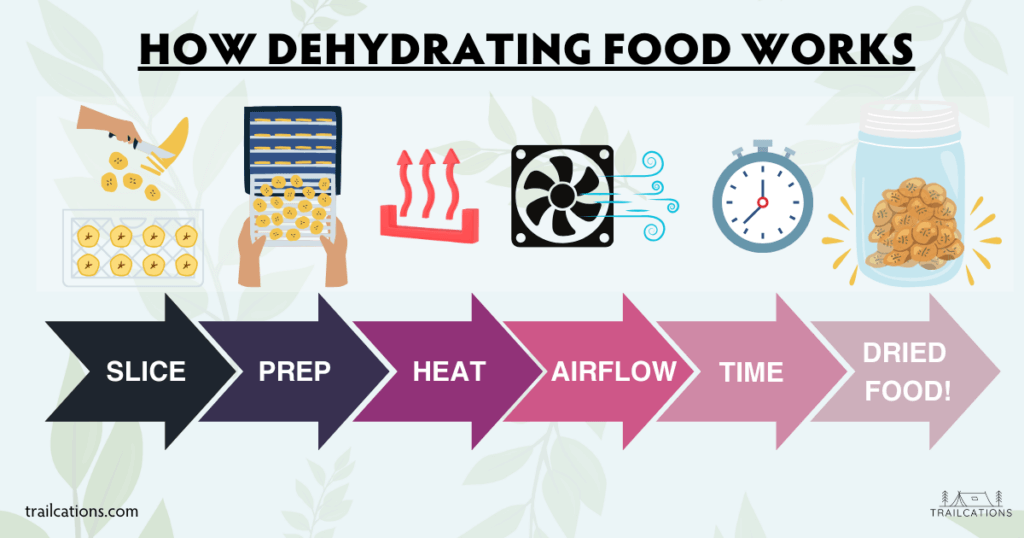
How Dehydration Works
Dehydration is a process that involves removing the water content from food. By removing the water, you are essentially removing the moisture that bacteria and other microorganisms need to grow and thrive. This makes dehydrated foods less susceptible to spoilage and helps preserve their nutritional value. Still have questions? Check out Dehydrating 101: How a Food Dehydrator Works.
There are several ways to dehydrate food, including using a dehydrator, an oven or the sun, each with varying results. Some people even use the microwave, air fryers or toaster ovens to dehydrate food. Check out our article on 15 Different Ways to Dehydrate Food (Even Without Electricity).
Once the food is dehydrated, it can be stored in airtight containers to keep out moisture and air. Mason jars, vacuum seal bags and Tupperware are good options for storing dehydrated food.
Overall, dehydrated foods are an excellent option for those who want to eat healthy, save money and extend the shelf life of their food. By learning how to store dehydrated food properly, you can enjoy the health benefits for years to come.
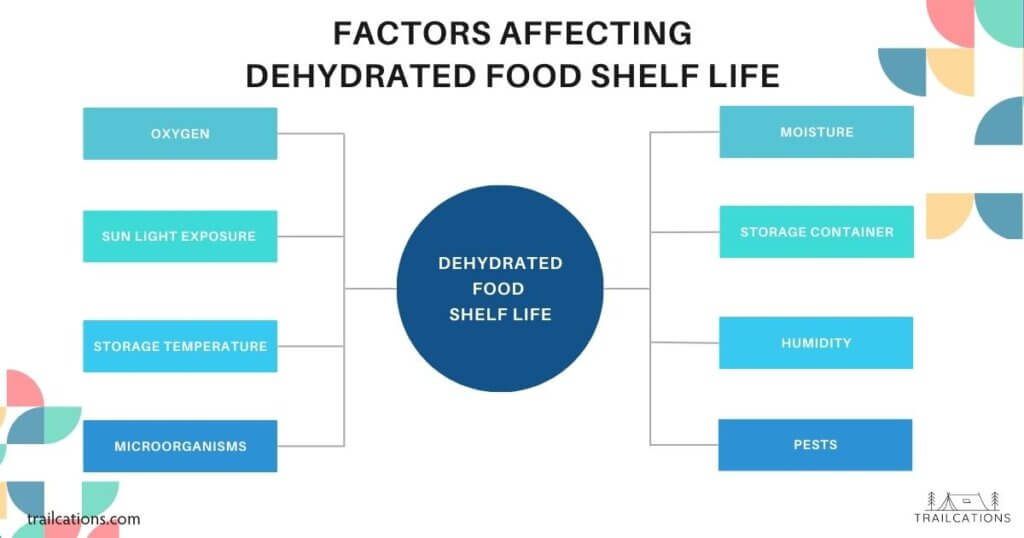
Factors to Consider When Storing Dehydrated Foods
When it comes to storing dehydrated foods, there are several factors you need to consider to ensure their longevity and quality. Here are some of the most important factors you should keep in mind:
Light and Oxygen Exposure
Dehydrated foods can be susceptible to damage from light and oxygen exposure. Exposure to light can cause discoloration and loss of nutrients, while oxygen can cause oxidation and spoilage.
To prevent these issues, store your dehydrated foods in airtight containers that are opaque or dark in color. You can also use oxygen absorbers to remove any excess oxygen from the container.
Moisture and Humidity
Moisture and humidity can lead to the growth of bacteria and mold, which can spoil your dehydrated foods. To prevent this, store your dehydrated foods in a dry environment with low humidity.
Avoid storing dehydrated foods in areas with high humidity, such as a damp basement or near water pipes. Instead, store them in a cool, dry place like a pantry or cupboard.
Temperature
The temperature at which you store your dehydrated foods can also affect their shelf-life. High temperatures can cause the food to spoil or lose its nutritional quality. Low temperatures can cause condensation and moisture buildup.
Store your dehydrated foods in a cool, dry place with a consistent temperature. Food quality is affected by heat so storage temperatures should be less than 60°F (15°C) (NCHFP). Shelf life can be reduced by half when you raise storage temperatures to 80°F (27°C).
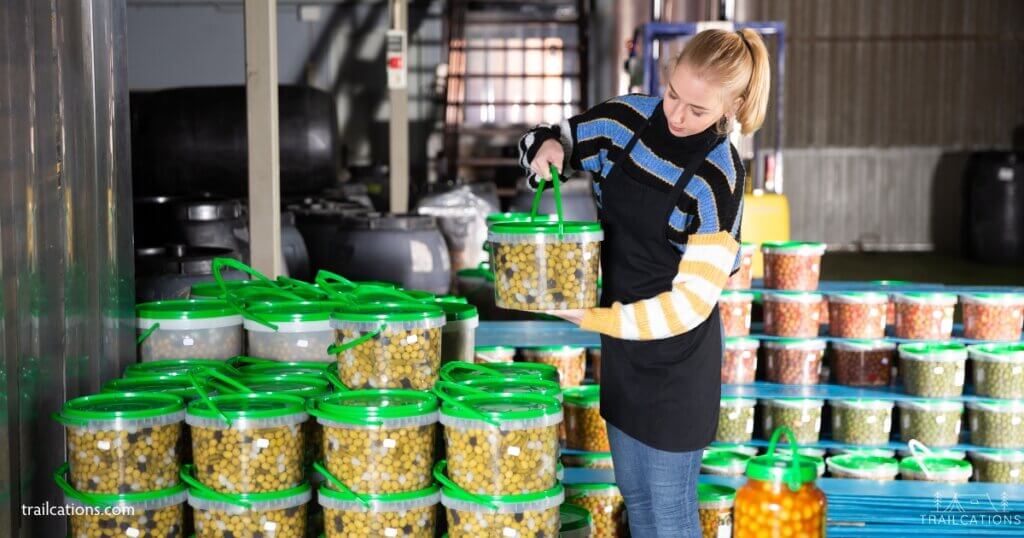
Pests and Bacteria
Finally, pests and bacteria can also be a concern when storing dehydrated foods. To prevent pests infestations, store your dehydrated foods in hard sided airtight containers. This might mean bagging the food first and then placing in a food grade bucket.
Pests can include rodents like mice, family pets like cats and dogs or insects like hungry ants. Even though packages are sealed airtight, animals tend to have much stronger senses of smell than us. We’ve actually lost a couple food bags to our roommate’s food-crazy cat who couldn’t resist the crunch of dried ham!
To prevent the growth of bacteria, make sure your dehydrated foods are completely dry before storing them. Condition your foods for 3 to 7 days after dehydrating to ensure there are no signs of moisture. You can also consider using a food dehydrator with a built-in thermometer to ensure the food is fully dehydrated.
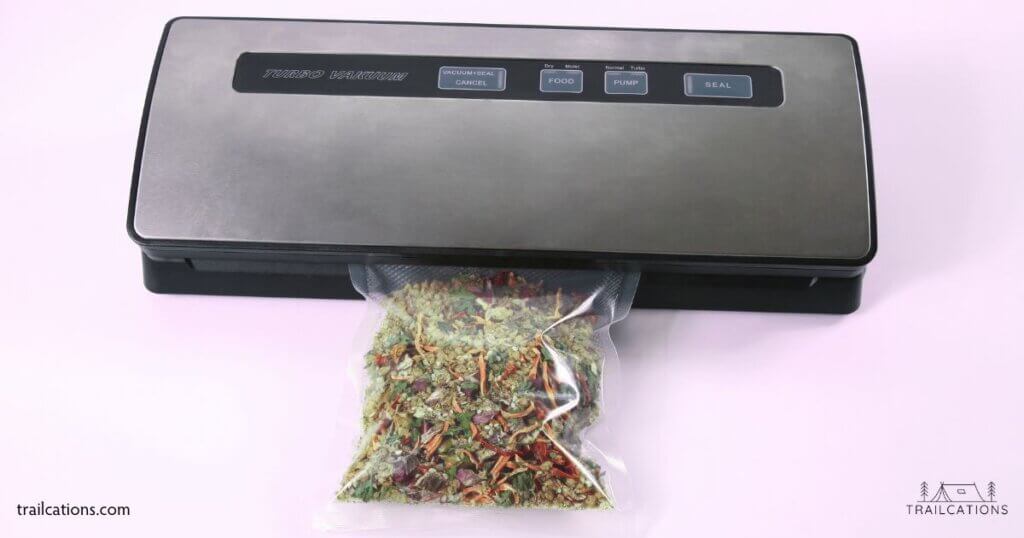
Storage Containers and Methods for Storing Dehydrated Food
Proper storage of dehydrated food is essential to maintain its quality and freshness. Here are some of the best storage containers and methods to help you preserve your dehydrated food for as long as possible:
Airtight Containers for Dehydrated Food Storage
One of the best ways to store dehydrated food is in airtight containers. These containers prevent moisture, air, and pests from getting into your food. These can cause spoilage and affect the quality of your food. Plastic containers, glass jars and mason jars are all great options for airtight containers.
Alternatively, vacuum seal bags and Mylar bags are excellent for keeping oxygen and moisture out. For extra protection, store vacuum seal or Mylar bags in hard sided food grade buckets or 5 gallon buckets.
Labeling and First In, First Out (FIFO)
When storing dehydrated food, it’s important to label your containers with the contents and date of dehydration. This will help you keep track of what you have and when it was made. Additionally, using the first in, first out (FIFO) method will ensure that you use the oldest food first. This helps prevent waste and ensures that you always have fresh food on hand.
Vacuum Sealing
Vacuum sealing is another great preservation method for dehydrated food. By removing the oxygen from the container, you can prevent spoilage and extend the shelf life of your food. Vacuum-sealed bags are a popular option for this method. However, you can also use canning jars, vacuum seal Tupperware or other containers that are designed for vacuum sealing.
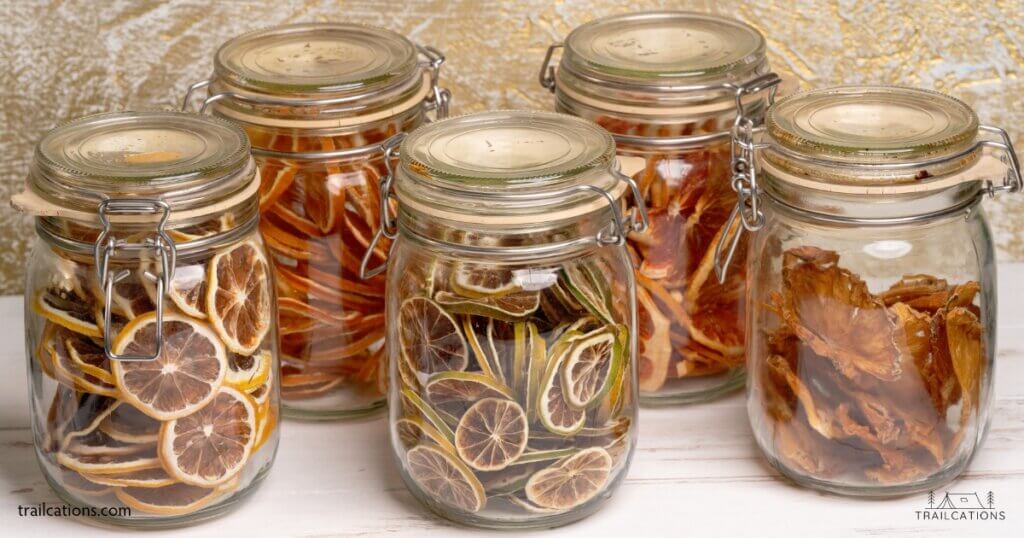
Conditioning
Before storing your dehydrated food, it’s important to condition it first. Conditioning the food ensures that the moisture in the individual pieces of food is evenly distributed throughout the batch. This final quality check helps prevent the growth of bacteria and mold, which can spoil your food over time.
Conditioning is a preliminary drying period where you check food daily for signs of moisture before placing it into long term storage.
- First, allow the dried food cool briefly on the dehydrator trays for 30 to 60 minutes.
- Next place the cooled food in an airtight container (preferably clear).
- Let the airtight container sit for 3 to 7 days. Every day, shake the food container and check to make sure there is no moisture.
- If moisture appears on the container or plastic bag in the form of condensation, stop the conditioning process. Immediately return the entire batch of food to the dehydrator and dry for several hours. Recondition the food before placing it into long term storage.
- If you see any signs of mold or bad smells, you will need to throw out the entire batch of food. Unfortunately, at this point it is beyond the point of saving. Mold spores, yeasts and bad bacteria have contaminated your food and can’t be safely killed by a dehydrator. It is better to be safe than spend several days on the toilet from food poisoning.

How Do You Know If Your Dehydrated Food is Dry Enough?
It’s important to know that your food is dry enough before storing your dehydrated ingredients long term. Too much moisture and your food can spoil, become rancid or allow harmful microorganisms to grow. There are some simple tests you can use to determine dehydrated food doneness using senses like sight, sound and feel.
Fruits – leathery, not sticky (unless high sugar fruits like raisins/dates), pliable.
Vegetables – hard, brittle, shatters when hit, sounds like pebble when dropped
Meats – leathery, hard edges, dry, tough
Mushrooms – hard, leathery, sharp edged
Fruit Leathers – pliable, not tacky, leathery
Herbs – brittle, crumbles under pressure, crispy
Grains – hard, sounds like pebble when dropped
Learn more about Dehydrating 101 here! From pretreatment to testing for doneness to choosing the best food dehydrator, we’ve got you covered.
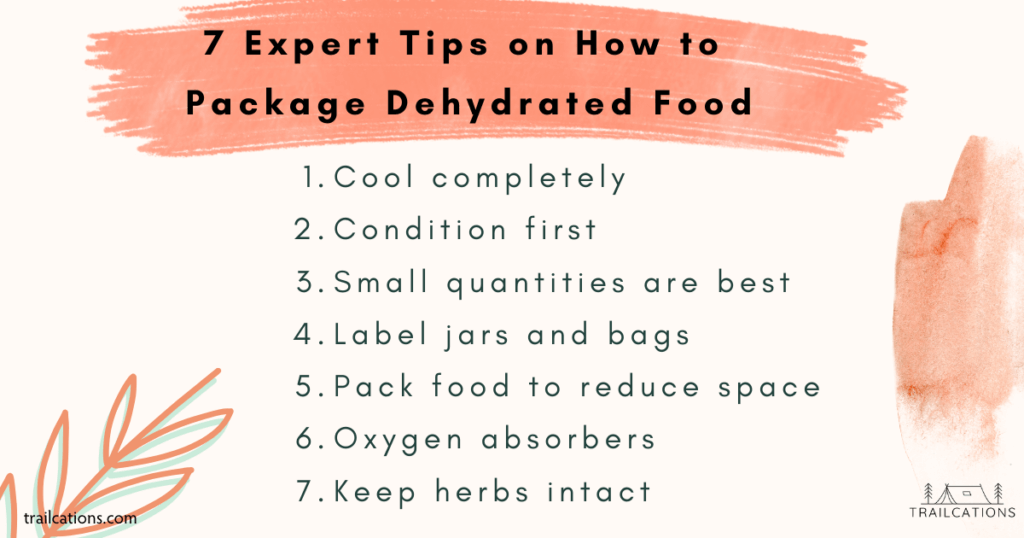
7 Expert Tips on How to Package Dehydrated Food
Always package dehydrated food should in clean airtight containers. Label and store your dehydrated ingredients in a cool, dark, dry place. We recommend to never mix different types of food unless you’re combining them in meals. Strong smelling foods like onions, mushrooms and garlic can leave off-flavors in other foods like blueberries, pasta and greens.
1) Cool Completely
To package dehydrated food, it’s important to make sure it’s completely cool to the touch before packaging it. Packaging warm dried food causes moisture to be released when it cools. This unfortunately can lead to spoilage.
2) Condition First
Once the food is cool, pack it into clean, dry, airtight containers such as home canning jars, plastic freezer containers with tight-fitting lids, or plastic freezer bags. Condition fruits and vegetables by placing them in clear airtight containers for 3 to 7 days, checking for moisture daily. It is heartbreaking to put “dried” food in storage only to find out that it molded a couple months later.
3) Small Quantities Are Best
For long term storage, pack food inside containers that match the size of the food. Smaller containers reduce the amount of oxygen exposure and degradation of nutrients like Vitamin C. Pack foods in the amounts that will be used in a recipe. Every time a package is opened, oxygen and moisture reduce the quality and shelf life of the food.
4) Label Jars and Bags
Label the food container with the name of the food, dehydration date and estimated expiration date. Dried foods, especially herbs and powders, look very similar when you have a lot of them. Check out the USDA recommendedshelf life app for home dehydrated foods to remind yourself about estimated home dried food storage life.
5) Pack Food to Reduce Oxidation and Save Space
To save space for long term dehydrated food storage and reduce oxygen exposure, it’s important to pack the food as tightly as possible without crushing it. Vacuum packaging is another option and to shrink food for storage. This is done using a small kitchen appliance called a vacuum sealer (NCHFP). Vacuum sealing dehydrated food removes damaging oxygen which can decrease storage times and degrade vitamins.
6) Oxygen Absorbers
Add an oxygen absorbing packet prior to vacuum sealing your food to further extend shelf life. Only use food grade oxygen absorbers – NOT silica gel packets. Silica gel bead packets generally aren’t food safe and may contain residue that can leach into your food.
7) Keep Herbs, Spices and Flavor Powders Intact
To best preserve flavor and shelf life, keep herbs, spices and flavor powders in their whole or intact form for long term storage. When you grind or powder a food, you expose more of it to the air which reduces shelf life and nutrient content. Wait until just before assembling dehydrated meals or cooking with your herbs to grind or powder your herbs, spices and powders.
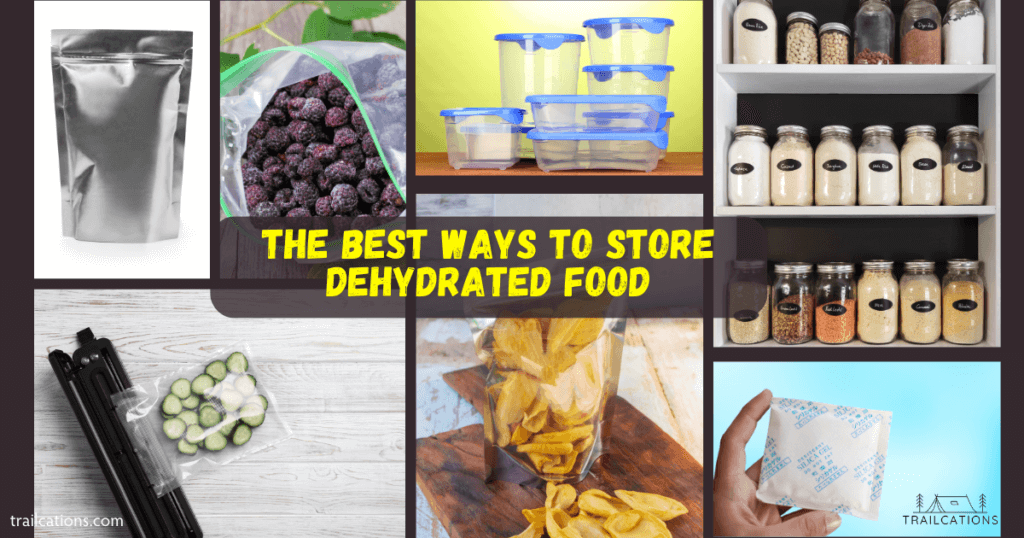
What is the Best Way to Store Dehydrated Food?
The best way to store dehydrated food is to store it in an airtight container in a cool, dry and dark place, away from sunlight and moisture. Airtight containers such as mason jars or vacuum-sealed bags prevent moisture, oxygen and pests from getting in. Labeling the containers with the contents and date of dehydration can also be helpful since dried food can look similar.
It’s also important to make sure the food is completely cool before storing it to prevent moisture from forming inside the container. Condition dried food by letting it sit in clear, airtight containers for several days allows moisture levels to equalize and help you visually check for moisture. Additionally, vacuum sealing containers and using oxygen absorbing packets can help keep the food dry and fresh.
Here are some options for storing home dehydrated food:
- Mason or canning jars: Excellent for pantry storage and easy access to the food. Clear jars are great to see food and check for signs of moisture.
- Plastic vacuum seal bags: These bags evacuate almost all nutrient sapping oxygen and moisture. When sealed with an oxygen absorber, vacuum seal bags off a great method for long term storage of dehydrated food.
- Ziploc bags: These are a decent temporary storage solution. However, they may not prevent air and moisture from entering the bag over time. Long term these bags can leach plastic into your food which tastes awful (unfortunately we know from experience).
- Vacuum seal Tupperware: Can be expensive to purchase but offers easy access to food and unparalleled airtight seals.
- Food Grade Mylar bags: These high quality bags can extend the shelf life of your dried food, especially when vacuum-sealed.

What is the Best Storage Bag for Dehydrated Food?
Mylar Bags
Mylar bags are considered some of the best storage bags for dehydrated food, especially the versions that can be vacuum sealed. They are lightweight, tearproof and block air and light from degrading the food, making them ideal for long-term storage. Thick mylar bags are sturdy and are not easily punctured by sharp dehydrated foods. Store mylar bags in hard sided food grade buckets as they are not animal-proof.
You’ll need extra equipment to use the vacuum seal versions of Mylar food bags. Your typical vacuum sealer that uses plastic vacuum seal bags (ex: like a Food Saver) won’t work to seal the shiny Mylar bags properly. Instead, use a chamber vacuum sealer to vacuum seal Mylar bags for long term dehydrated food storage.
Mylar bags with clear windows or zip top closures are not the best for long term food storage as they are air permeable. This means oxygen, moisture and microorganisms can get in through the microscopic gaps. These are fine options for gift-giving or short term storage. For maximum shelf life, always choose the completely silver vacuum seal mylar bags.
How Long Will Dehydrated Food Last in a Mylar Bag?
Most dehydrated food in mylar bags lasts about the same as it would in any airtight container (Mylarshop, Epac). However, if you throw in an oxygen absorber and vacuum seal the dehydrated food in a mylar bag, you may be able to extend the shelf life of certain low-moisture, fat-free foods.
Some dehydrating websites claim that mylar bags will extend the shelf-life of dehydrated fruits and vegetables to 25 years or more. However, I’ve found that most fruits and vegetables tend to lose their quality, flavor and texture after about a year or two due to a home dehydrator only being able to remove 80 to 95% of the moisture in a food. On the other hand, freeze-dried foods remove almost 99% of the moisture of a food and when properly stored in mylar bags, they can last between 20 and 30 years (Mylarshop.com).
Mylar bag manufacturers indicate that certain types of low moisture dried foods can last many years when stored in mylar bags (Mylarshop, Epac). Dried grains like quinoa, rice, wheat and pastas tend to last many years in mylar bags without degradation of quality.
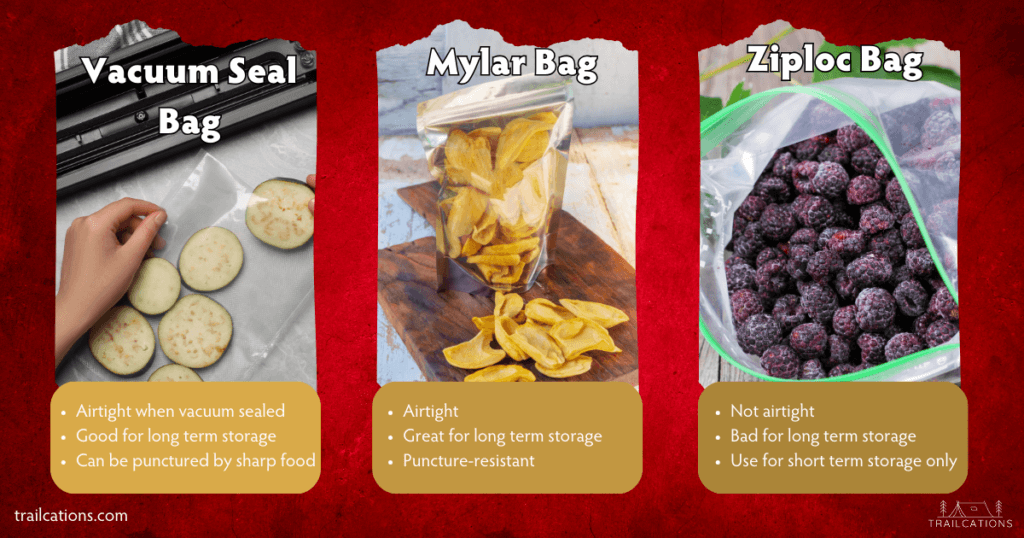
Vacuum Seal Bags
Plastic vacuum seal bags are great options for long term food storage bags if your dehydrated ingredients are not sharp or pointed. Unfortunately, many dried foods become hard with sharp and pointy edges that puncture right through the plastic bag when vacuum sealed. I’m looking at you mushrooms and carrots!
You’ll notice your vacuum sealer whirring away for an extra long time, trying to draw a vacuum from a punctured bag. Unfortunately, punctured vacuum seal bags will allow air, moisture and microorganisms in, causing food to spoil quickly.
To avoid puncturing vacuum seal bags, you can wrap sharp dried food in parchment paper or a paper towel and then place it in the bag for sealing. Shaking the food to allow it to lie flat can also help reduce punctures. Finally, using a larger sized bag allows the food to move around during vacuum sealing process and reduce stacking of food with sharp points.
How Many Years Will Dehydrated Food Last in Vacuum Sealed Bags?
Dehydrated food stored in vacuum-sealed bags with an oxygen absorber can last for a very long time, up to several years. Some websites claim dehydrated foods in vacuum seal bags can last 25 to 30 years or longer but these would have be very low moisture foods like rice, oats and beans. We use the USDA Food Keeper guidelines for home dehydrated food shelf life and err on the side of caution.
The actual shelf life of vacuum-sealed dehydrated food depends on factors such as the type of food, how it was prepared and how it is stored. It’s important to make sure the food is completely cool and dry before conditioning the food. After a few days with no signs of moisture, it is likely safe to vacuum seal the dried food and store it in a cool, dry, and dark place to prevent moisture and light from getting in.
If a vacuum seal bag has become punctured, it is important to consume the food right away or throw it out if it shows signs of mold.
Plastic Zipper Top (Ziploc) Style Bags
Plastic zipper top bags are not good for long term storage as they are too permeable to air and moisture and can also leach chemicals into your food if stored for several months. Studies have shown that the longer polyethylene (the material Ziploc bags are made from) is in contact with food, the more additives from the manufacturing process leach into food (Hahladakis JN 2018, Zimmerman L 2021, Yang CZ 2011).
We also know about chemicals leaching from zip top style bags into dehydrated food from our unfortunate first-hand experience of having to throw away many months’ worth (and hundreds of dollars) of dehydrated food on our thru-hike of the Appalachian Trail. Even a group of us starving, calorie-deficient hikers who wouldn’t think twice about eating food off the ground couldn’t stomach more than a bite or two of home dehydrated food stored in ziploc bags for months.
(Editor’s Note: I am literally gagging writing this and remembering the intense, chemical flavor of my ziploc bag dried food and having to shove it down my gullet or go hungry. Ugh.)
The thick freezer storage plastic zip top bags are best for storing items short term. These include:
- fruit leathers going into the fridge for a couple days
- jerky going into the freezer for a month
- dried fruit snacks going to be eaten over the weekend on your camping trip
However, we recommend using Ziploc style bags to only store dehydrated food that will be consumed short term (ex: next couple of weeks).
Can You Store Dehydrated Food in Ziploc Bags?
You can store dehydrated foods in ziploc bags but be aware of their limitations for keeping oxygen, moisture and chemical additives from the manufacturing process out. We recommend that you only store dehydrated food in ziploc bags for short-term storage. Besides the zip tops allowing small amounts of air and moisture in, we’ve found from personal experience that the plastic used in these bags leaches chemicals into your food after several months.
Personal Experience with Storing Dehydrated Food in Ziploc Bags
Unfortunately, we’ve ruined entire months’ worth of dehydrated food by storing it in ziploc bags (this includes both off brand and, yes, even the Ziploc brand name). The chemical flavors the come out of the plastic made the food so unpalatable that a whole group of us who tried the food immediately spit it out.
Thinking it was a bad batch of food, I continued to eat different home dried foods over many months that had been stored in the ziploc bags. However, it was always the same terrible chemical taste that seemed to get worse over time. I ended up throwing away entire resupply boxes of home dried food on my thru-hike because of the taste. The dehydrated food was stored in mailing boxes a cool, dark, dry environment at my parents’ house at around 60-65°F (15-18°C). Then it was mailed to post offices where it stayed in their back storage room for a few days to a week or two.
Research on Long Term Storage of Dehydrated Food in Ziploc Style Bags
Research studies have shown that over time, additives used in the polypropylene manufacturing process can leach out into food stored in bags and packaging made from this type of plastic. Leaching rates are increased with the duration of contact time, oxidation, moisture levels of the food and ambient humidity (Kolkaj AJ, NIH 2022, Hahladakis JN, Journal of Hazardous Materials 2018).
Today we only store dehydrated food in ziploc bags that we’re going to use within the next week or two. They are great tools for portioning dehydrating meals and snacks that will be consumed in next week’s camping trip or an impromptu after-work paddling trip that evening.
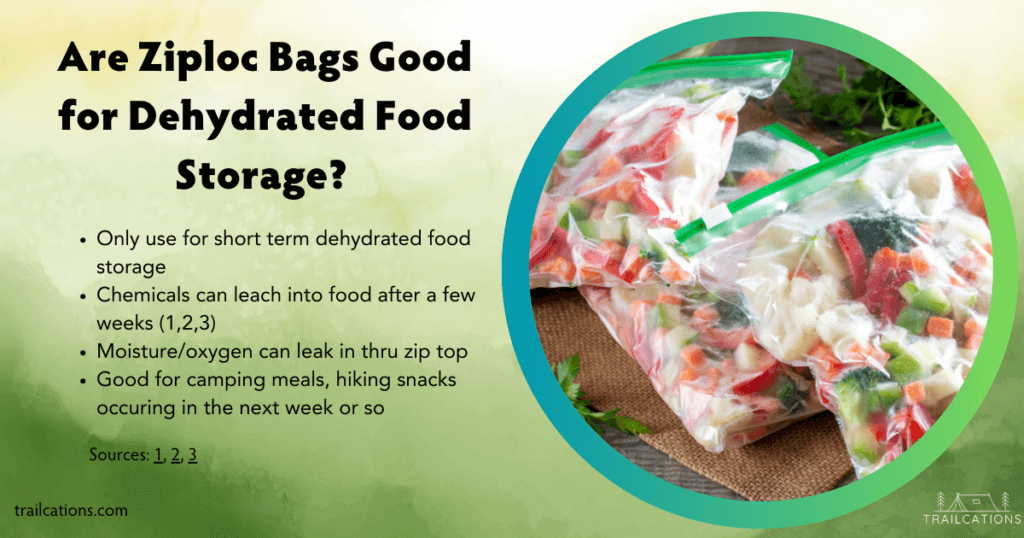
Are Ziploc Plastic Bags Safe for Food Storage?
What the SC Johnson Company Says (or Doesn’t Say) About Long Term Food Storage in Ziploc Bags
On the Ziploc website, the SC Johnson company does a great job advertising that their ziploc bags are BPA-free (a known carcinogen) and dioxin-free (a collective name for hundreds of toxic chemicals proven to cause cancer, reproductive harm, etc.). They also state that their Ziploc products meet certain FDA standards for microwaving and freezing temperatures when followed in accordance to label directions.
What you don’t see on Ziploc bag packaging labels is specific language regarding long term food storage at room temperature. Their freezer bags specifically call out their purpose for storing food in the freezer. Ziploc’s storage bags are labeled to indicate they are for storing food in the refrigerator. It is inferred that you only store food for a short amount of time in the fridge, like fresh vegetables which have 1-2 weeks shelf lives. However, there is no specific wording called out on the Ziploc bag packaging or Ziploc website on how long food should or should not be stored in these products.
What Research Studies Show About Long Term Food Storage in Polyethylene Bags (aka Ziploc and Other Zip Top Style Bags)
Several studies have shown that polyethylene used in consumer products like Ziploc bags, food packaging and plastic food wrappings can leach various chemical additives into food in as little as 10 days (Hahladakis JN 2018, Zimmerman L 2021, Yang CZ 2011). The longer the food is exposed to this type of plastic, the more additives leach into the food. Increases in temperature and humidity have also been shown increase the amount of chemicals leached into the food from polyethylene bags (Hahladakis JN, Journal of Hazardous Materials 2018).
Not all of these additives leaching into your food from long term storage in plastic zip top bags have been demonstrated to have toxic or long term effects on human health. However, they’re a few nasty additives shown to leach into foods from plastic bags, like BHT, that have been banned for use in food in countries such as the UK, Japan, parts of Europe and Canada. Surprisingly, studies on long term effects of BHT have been determined by the US government to be inconclusive enough to still allow the additive to be used in food consumption and food containers in the USA. However, in other parts of the world BHT has been considered toxic or questionable enough to ban its use in food.
So should you store dehydrated food in Ziploc style bags?
Speaking from personal experience of storing dehydrated food for many months in Ziploc bags and having it become unpalatable not only to myself but several other starving thru-hikers (all of us who would eat food off the ground in a heartbeat), I would NOT store dehydrated food in ziploc style bags long term.
After researching studies on additives leaching into foods from polyethylene bags and packaging, I would also recommend to others to not store dehydrated food long term in ziploc style bags. Finally, nowhere on the Ziploc website and packaging does the SC Johnson company indicate that these polyethylene bags are appropriate for long term food storage at room temperature.
Save your health, the quality of your food and shelf life of your ingredients and instead opt to store your dehydrated food in airtight containers like glass canning jars. If you’re going to store dehydrated food in Ziploc style bags, only do it for short term consumption within the next week or two to avoid additives and chemicals leaching into your food.
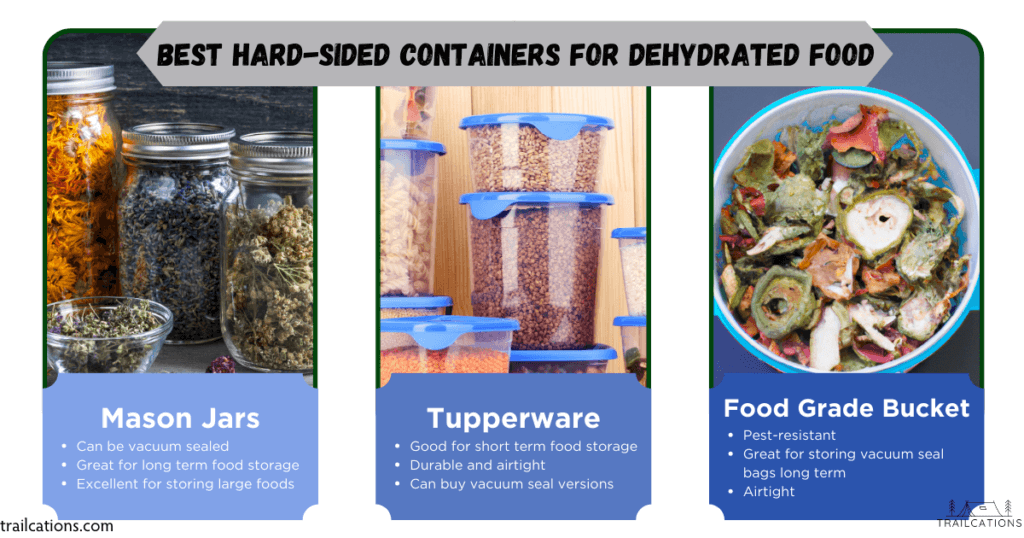
Other Options for Dehydrated Food Storage Containers
Other great options for storing dehydrated food include:
- airtight containers (ex: glass or plastic Tupperware)
- canning jars that have been vacuum sealed with a vacuum sealer jar attachment
- food grade storage buckets
Continue reading to learn more about these types of hard-sided storage options for dehydrated foods.
Tupperware and Vacuum-Seal Tupperware
Tupperware is a relatively inexpensive option for storing dehydrated foods short term, seeing as many people already own some version of this. It is also important to ensure that the Tupperware is not old or cracked, as this could lead to harmful bacteria getting into your food.
There are more pricy vacuum-seal versions of Tupperware that contain a vacuum port compatible with most vacuum sealing jar attachments. These are great options for long term storage of dehydrated food as they contain a thicker, more durable airtight vacuum seal compared to regular Tupperware.
We love storing our fruit leathers, veggie chips and dehydrated fruit snacks in Tupperware because of how easy it is to open and close the container. Keep in mind that every time you open a dehydrated food container, you expose the food to moisture, oxygen and bacteria and decrease its shelf life. Use Tupperware for short term dehydrated food storage.
Food Grade Storage Buckets
Home dehydrating enthusiasts primarily use food grade storage buckets for storing dehydrated food vacuum sealed in mylar or plastic bags. Manufacturers make these airtight containers with thick plastic compliant to FDA regulations for contact with food. The buckets have seals that prevent oxygen, moisture and most importantly pests from contaminating your emergency food stores.
Always choose food grade style storage buckets. Manufacturers of non-food grade buckets, like your typical 5 gallon bucket, can use harmful additives in the manufacturing process that can leach into your food.
Luckily, food grade buckets come in a range of sizes with snap on, screw on or clamp on lids to prevent air, moisture, UV light and pests from getting inside. They offer extra protection for long-term dehydrated food storage. These buckets are easily stackable and are great ways to grow your dehydrated food pantry and emergency food storage supplies.
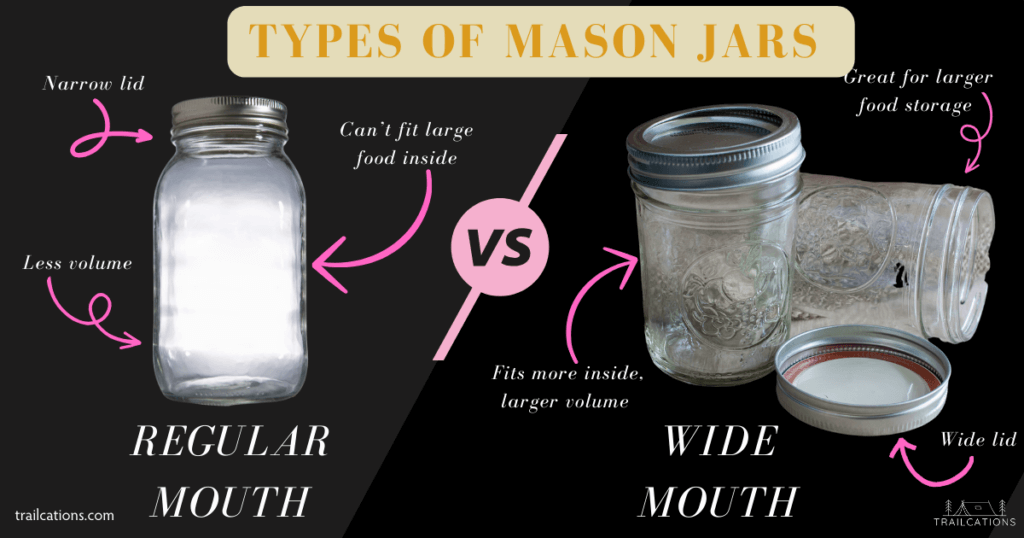
What is the Best Jar to Store Dehydrated Food in?
Mason Jars (aka Canning Jars, Ball Jars)
Mason jars are a popular and convenient choice for storing dehydrated food. Canning jars, Ball jars and Mason jars are essentially the same thing, with the only difference being brand name or depending on who you are talking to.
Airtight mason jars come in various sizes and are readily available at most stores. You can vacuum-seal mason jars for added protection from oxygen, moisture and food spoilage. It’s important to make sure the jars are clean and dry before storing the dehydrated food in them.
Many dehydrating enthusiasts recommend using wide-mouthed canning jars vs. the regular-mouthed jars.
Regular-Mouthed Jars: Regular-mouthed jars have a taper at the top and bottom and a smaller lid diameter. It can be difficult to fit in larger dehydrated items like citrus slices, peppers and whole tomato chunks without smushing them.
Wide-Mouthed Jars: Wide-mouthed jars can hold more food as the jar sides are straight the whole way through and larger foods can fit inside the wide lid easier. Wide-mouth jars are also more stackable than the tapered regular-mouthed jars which is helpful if you have a lot of dried food to store in your pantry.
Vacuum Sealing Mason Jars
If you’ll be storing dehydrated food for the long term (several months or more), you’ll definitely want to invest in a vacuum sealer for mason jars. Vacuum sealing mason jars helps remove nutrient-damaging oxygen and moisture that reduce the shelf life of dehydrated food. You can check the integrity of the lid seal by slipping a butter knife, fingernail or jar key under the lid. That satisfying “shwoomp” sound of the vacuum seal breaking means that you know your dehydrated food inside is crispy, dry and full of nutrients.
Hand Pump – You can buy special mason jar lids with a vacuum port attachment in the center and a hand pump to vacuum out the air. We’ve used this with great success and it was a relatively inexpensive way to vacuum seal jars and get a forearm workout. Look for a good quality model as the cheap hand pump we had ended up wearing out after vacuuming a couple hundred jars. There were vacuum lid options for regular-mouth and wide-mouth jars.
Vacuum Seal Canning Jar Attachment – If you have a vacuum sealer appliance, you may already have a canning jar attachment already. More expensive vacuum sealers come with a plunger looking attachment that goes over the top of your standard jar lid (the flat part, not the ring that tightens down). The vacuum seal attachment comes with an extendable hose that easily suctions the air out of the mason jar.
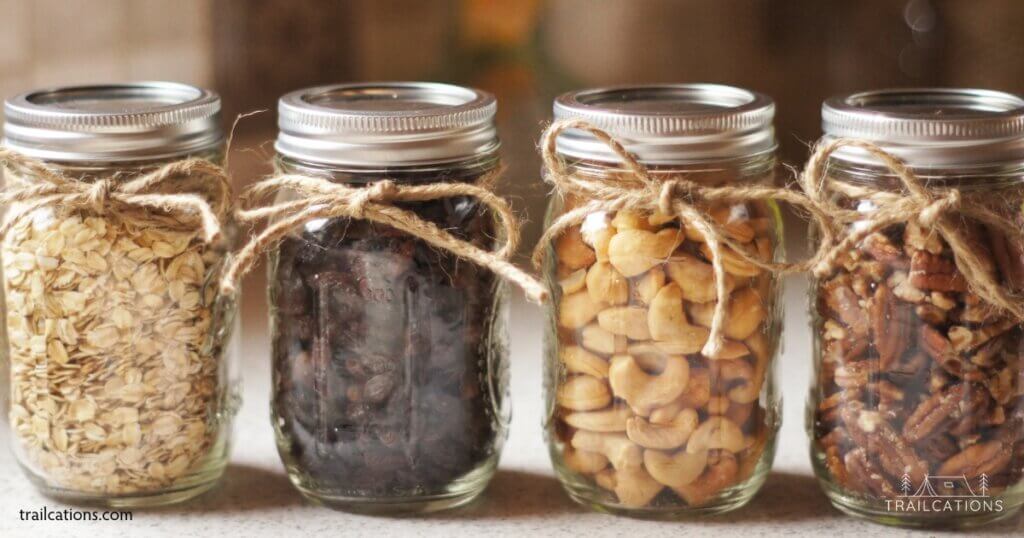
Can You Store Dehydrated Fruit in Mason Jars?
Yes, you can absolutely store dehydrated fruit in mason jars. In fact, mason jars are a popular and convenient choice for storing dehydrated fruit. Since dehydrated fruits tend to have high residual water content, it’s important to condition all dried fruit before placing it into long term storage. Place the entire batch of fruit back in the dehydrator with any signs of moisture collecting on the conditioning jar.
Mason jars are airtight and can help keep the fruit dry and fresh. The hard sides of the jar also prevent delicate dehydrated fruit slices from crumbling into pieces like in vacuum seal bags.
It’s important to make sure the jars and lids are clean and dry before using them, and to store the jars in a cool, dry, and dark place to prevent moisture and light from getting in. Labeling the jars with the contents and date of dehydration can also be helpful as dried fruit can look very similar, especially if you have a lot of it.
Why Do Seals Break on Dehydrated Food in Jars?
Seals can break on dehydrated food in jars for a few reasons. One common reason seals break is because the jar was not properly cleaned before use. Leftover food residue or debris will interfere with the seal.
Improperly vacuum-sealed jars will cause air to leak into the jar and break the seal. Make sure your vacuum sealer is working by trying to open the first jar. If you hear a “pop,” reseal your jar.
Food that was still warm from the dehydrator when stored can cause moisture to form inside the jar and break the seal. It’s important to make sure the jars and lids are clean and dry before using them, and to tighten the lids properly to ensure a good seal.
We’ve found that the seals break on our dehydrated food in jars more often than not when we move the food from one storage area to another. Always check the seals on jars that have been jostled and bumped. Always check to make sure you’re extra careful when transferring dehydrated food in jars from one storage area to another.
Additionally, it’s important to store the dehydrated food in a cool, dry, and dark place to prevent moisture from forming inside the jar.
How Long Does Dehydrated Food Last in Mason Jars?
Dehydrated food stored in mason jars lasts for months or even years. Shelf life depends on the type of food and how it is stored. Proper storage requires sealing the cleaned, dried jars properly with a vacuum sealer attachment and keeping them away from light, heat, moisture, and contaminants.
According to the USDA and the National Center for Home Food Preservation, when home dehydrated food is prepared, conditioned and stored properly, it should last anywhere between a few months to a few years. Throw out any mason jars that are cracked, chipped or have rusty lids. Damaged mason jars will let in oxygen, moisture and microorganisms.
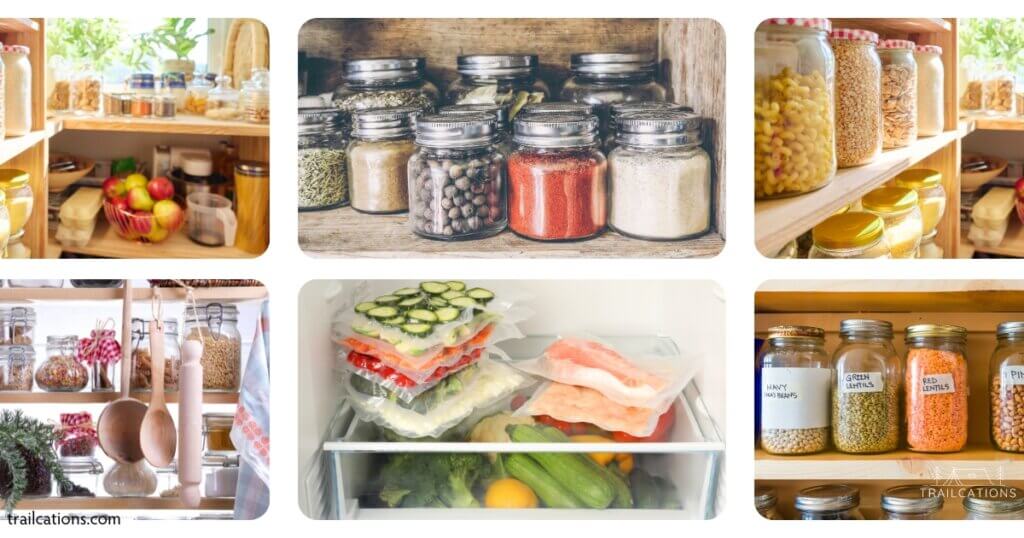
Where Should Dehydrated Food Be Stored?
Store dehydrated food in a cool, dry, dark place to help prevent spoilage and extend its shelf life. According to Food Safety Magazine, temperatures between 50-70°F (10-18°C) are ideal for storing dehydrated food but the cooler the better. Storage life is cut in half for every increase of 10°C (18°F) in temperature. A hot place like an uninsulated garage or attic in the summertime is not a good storage area.
Exposure to light can also degrade the quality of dehydrated food, so it’s best to store it in a dark place, such as a pantry or cupboard. UV rays from the sun can discolor food and sap away vitamins, nutrients and minerals.
It’s important to keep dehydrated food away from moisture and humidity, which can cause spoilage or mold growth. Never store dehydrated food near pipes, in a bathroom or in a damp basement. Ideal humidity levels in a storage area should be 15% or less which is quite dry. Air conditioners and dehumidifiers are excellent tools to reduce humidity, especially in the summer time or rainy seasons.
Airtight containers, such as mason jars, vacuum-sealed bags or Mylar bags with oxygen absorbers, are great options for storing dehydrated food, as they help to prevent air and moisture from getting in. It’s also important to label the containers with the contents and date of dehydration, and to check them periodically for signs of spoilage or moisture.
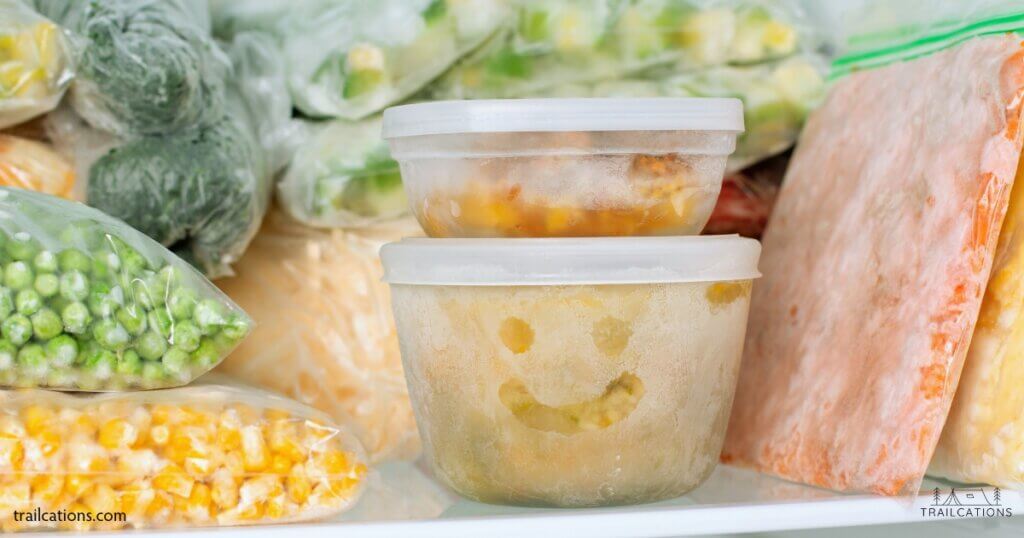
Can You Store Dehydrated Food in the Freezer?
Yes, you can store dehydrated food in the freezer to help extend its shelf life. Freezing dehydrated food can help to prevent spoilage and preserve the quality of the food for longer periods of time. However, it’s important to make sure that the dehydrated food is completely dry before freezing it, as any remaining moisture can cause freezer burn or ice crystals to form.
To freeze dehydrated food, place it in an airtight container, such as a freezer-safe bag or container, and store it in the freezer. Always make sure dehydrated food is placed in a freezer safe vapor barrier container or bag.
When you’re ready to use the food, allow it to thaw completely before rehydrating or using it in your recipe. Use thawed dehydrated food within 4 days.
It’s also important to label the container with the contents and date of dehydration and to use the oldest items first.
Why Freeze Food After Dehydrating?
Freezing food after dehydrating can help to further extend its shelf life by preventing the growth of bacteria and microorganisms. Even after dehydrating, some moisture may still remain in the food, which can cause it to spoil over time.
Additionally, freezing can help to preserve flavor, prevent insect infestations and protect the food from other types of contamination. However, it’s important to make sure that the dehydrated food is completely dry before freezing it, as any remaining moisture can cause freezer burn or ice crystals to form.
When you want to use the frozen dehydrated food, thaw it and consume within 4 days, storing it in the refrigerator that entire time. Residual moisture can appear from the freezing and thawing process so it’s important to consume the food right away.
To extend dehydrated food shelf life after the USDA recommended storage guidelines, the National Center for Home Food Preservation suggests placing it in the freezer. Freezing will not preserve food indefinitely but instead slows down the nutrient degradation process.
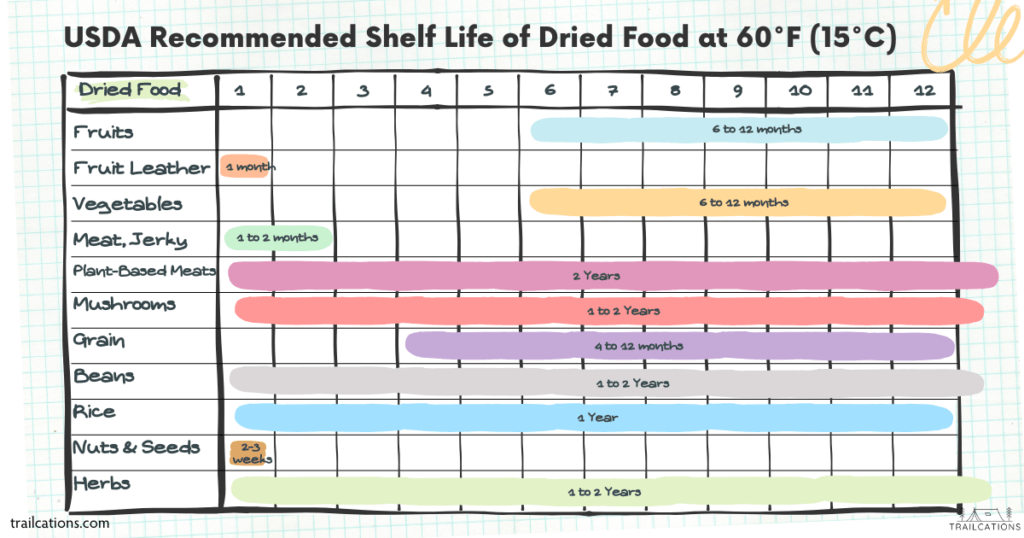
Sources: USDA Foodkeeper App, NCHFP, CSU Extension
What is the Shelf Life of Homemade Dehydrated Food?
When prepared, dried, conditioned and stored properly, most home dehydrated food has a shelf life of several months to a year. However, a lot depends on the storage environment and method. Here are research-based shelf life for dehydrated foods:
Fruits & Vegetables: 1 year for fruit, about 6 to 12 months for vegetables stored below 60°F (15°C) (CSU Extension, USDA).
Fruit Leathers: 1 month at room temperature, 1 year in the freezer. 1 week if there is added nuts, seeds, herbs in the mix (NCHFP, Excalibur).
Meat, Fish & Jerky: 1 to 2 months unopened in pantry or refrigerator. (USDA, USDA 2).
Grains: 4 months to 1 year (USDA).
Rice: 1 year (USDA).
Beans: 1 to 2 years (USDA).
Mushrooms: 1 to 2 years (USDA).
Nuts & Seeds: 2 to 3 weeks at room temperature. 1 to 9 months in refrigerator. 6 months to 1 year in freezer. (USDA).
Plant-Based Meats: 2 years (USDA).
Herbs: 1-2 years (USDA).
Many dehydrating enthusiasts report that their home dehydrated food lasts much longer than the shelf life guidelines listed above. These are the general guidelines our team follows based on the listed sources. Keep in mind that some foods might not last as long due to variation in dehydrating and storage processes.
How to Increase Shelf Life of Your Dehydrated Food
To achieve the longer end of the dehydrated food shelf life range, it’s important to store home dried food somewhere with no exposure to light, moisture and oxygen.
Pretreating food with an acidic solution will dramatically fend off bad bacteria growth that can spoil food. Alternatively, you can increase shelf life by making sure dehydrated food is completely dry by conditioning it before long term storage.
Simply using a vacuum sealer to remove air from your storage container and adding an oxygen absorber can go a long way to extending the long term shelf life of your dried food.
When in doubt whether a food is still safe to eat, throw out anything that looks or smells questionable!
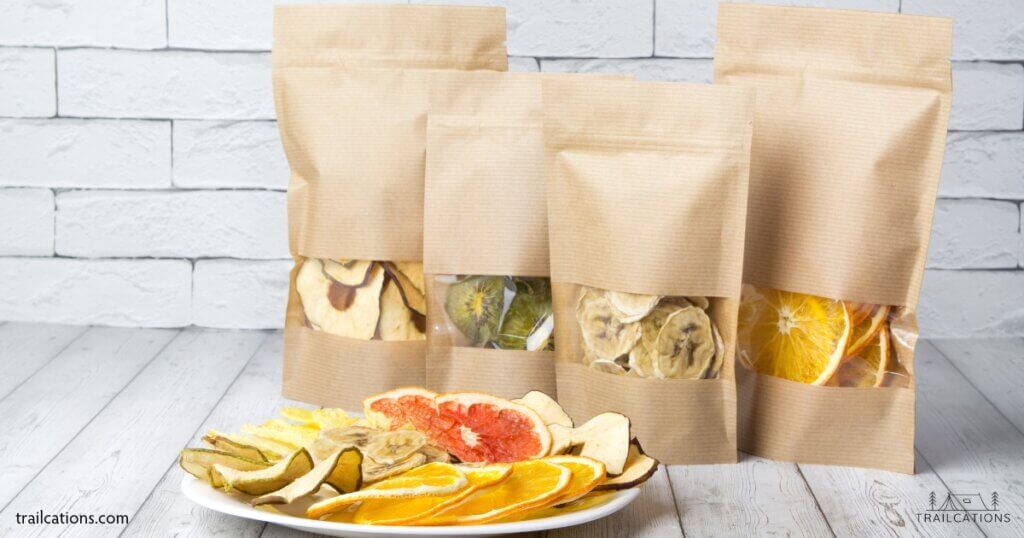
How to Store Dehydrated Food for Long Term?
To store dehydrated food for long term, it’s important to keep it in a cool, dry and dark place, far away from sunlight and moisture. It’s best to store dehydrated food in airtight containers, such as mason jars or vacuum-sealed bags, to prevent moisture from getting in. Adding an oxygen absorber to the container can also help extend the shelf life of the food. Labeling the containers with the contents and date of dehydration can also be helpful.
It’s important to make sure the food is completely cool and dry before storing it, and to check the containers periodically for signs of spoilage or moisture. Here are some reasons why dehydrated food needs to be stored in a specific manner:
Sunlight
The ultraviolet rays of the sun can damage the nutritional value and quality of the food. Vitamins A, D, E, and K are especially sensitive to sunlight so make sure food is stored somewhere without windows like a closet, pantry or cupboard.
Storage Temperature
Most dehydrating experts recommend dehydrated food storage temperature of less than 60°F (15°C) for maximum shelf life although 50°F to 70°F (10°C to 21°C) will work as well. Hotter storage areas, like an attic in summer, will seriously degrade the shelf life of dehydrated food causing it to spoil faster.
Humidity
Storage areas should ideally have a humidity level of less than 15% which may be impossible unless you live in a desert. Consider using a dehumidifier or air conditioner during hot, humid times of the year. Alternatively using packaging that is waterproof like vacuum seal bags, canning jars or mylar bags will help prevent outside moisture content from reaching your dried food.
Oxygen Exposure
Dried food should be stored in airtight containers like Tupperware, mason or canning jars, vacuum seal bags or Mylar bags. Oxygen can degrade vitamins, food appearance and nutrient content, as well as introduce microorganisms that can cause food poisoning.
Moisture Reabsorption
Dehydrated foods that appear to be bone dry can quickly reabsorb ambient moisture if their containers are reopened during storage. Try to limit the amount of times a dehydrated food storage container is opened and package in smaller quantities to avoid large batches of food from spoiling. Check your dried ingredients frequently during storage to ensure that they’re still dry. Glass containers are excellent options for storage because any moisture collecting inside can easily be spotted.
If you notice moisture in your food but it’s not spoiled or rotten, the food should either be consumed immediately or put back in the dehydrator for a few hours and repackaged. Any food that is moldy, smells bad or looks “off” should be thrown away.
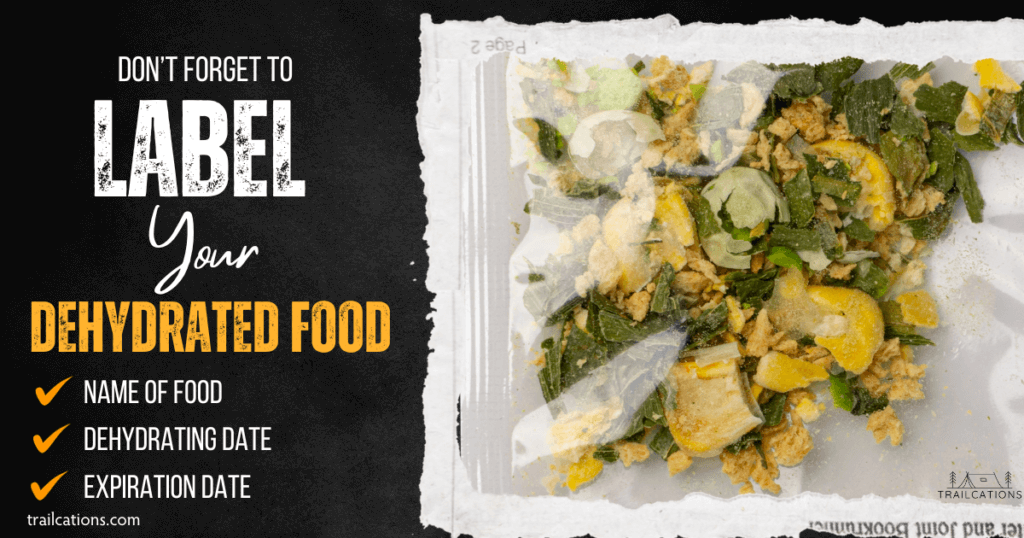
Labelling
Label each batch of dried food with the ingredient name, dehydration date and expiration date. Speaking from experience, it can be surprisingly difficult to distinguish between the various little dried up bits of food after a couple months. If you have measured out and assembled entire dehydrated meals, label those and the required amount of water needed to rehydrate them in the backcountry.
Pest Proofing for Dehydrated Food Storage
Dehydrated food can be irresistible to animals looking for a high-calorie, low-effort snack. Small rodents like mice, rats and chipmunks can easily chew through vacuum sealed plastic bags and even mylar bags. Determined pets like dogs and cats can easily chew through or break into containers storing tasty dried meat, vegetables and fruits while you’re not looking. Finally, insects like ants, beetles and flies can invade punctured food bags and spoil your dehydrated food stores.
Make sure to double-bag any dehydrated food in soft containers (like vacuum seal or mylar bags) into a hard-sided container like a food grade bucket or cooler. My roommates’ large food crazy cat once chewed through a Tupperware container to get at dried ham in a plastic bag. In the backcountry, dehydrated food storage is even more important with hungry raccoons, bears, foxes and other wildlife looking for quick snacks.
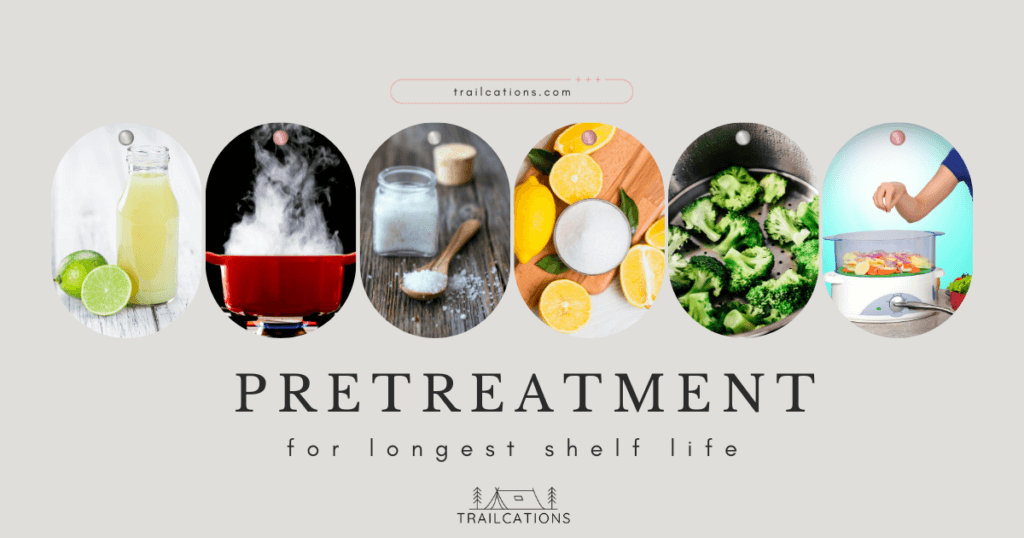
Pretreatment for Longest Dehydrated Food Shelf Life
Research studies have shown that pretreating fruits and vegetables prior to drying increases shelf life by destroying bacteria that cause foodborne illness and slowing oxidation.
Pretreating foods with an acidic or salt solution are effective at preventing bad bacteria like E. coli, Salmonella and Listeria from growing.
Acidic solutions typically are water mixed with ascorbic acid (Vitamin C powder), citric acid powder or citrus juice like lemon, lime or unsweetened pineapple. Food slices are dipped into the acidic solution for 3 to 5 minutes, drained and placed on the dehydrator trays.
Salt solutions typically use industry standard preservatives like food grade sodium metabisulfite, a preservative often used in commercial dried fruit, meats, wine and canned food. However, metabisulfites can cause allergic reactions in people with asthma so it may be wise to stick to the acidic solutions for pretreating dehydrated food at home. Food slices are soaked for 5 to 15 minutes in metabisulfite dissolved in water, rinsed lightly and placed on dehydrator trays.
Steam blanching helps retain color in dense vegetables like root veggies, slows oxidation and reduces dehydration times in thick-skinned fruits. Water is boiled under a steamer insert and the food is placed in the steamer, covered and steamed for 2 to 10 minutes depending on the food type. Immediately place the food in an ice bath to stop cooking, cool, drain anyplace on dehydrator trays.
When we’re storing dehydrated food long term, we usually pretreat our food for best results. Whether we’re preventing oxidation or discouraging bad bacteria growth, pretreatment is a relatively easy way to extend shelf life of our dehydrated foods.
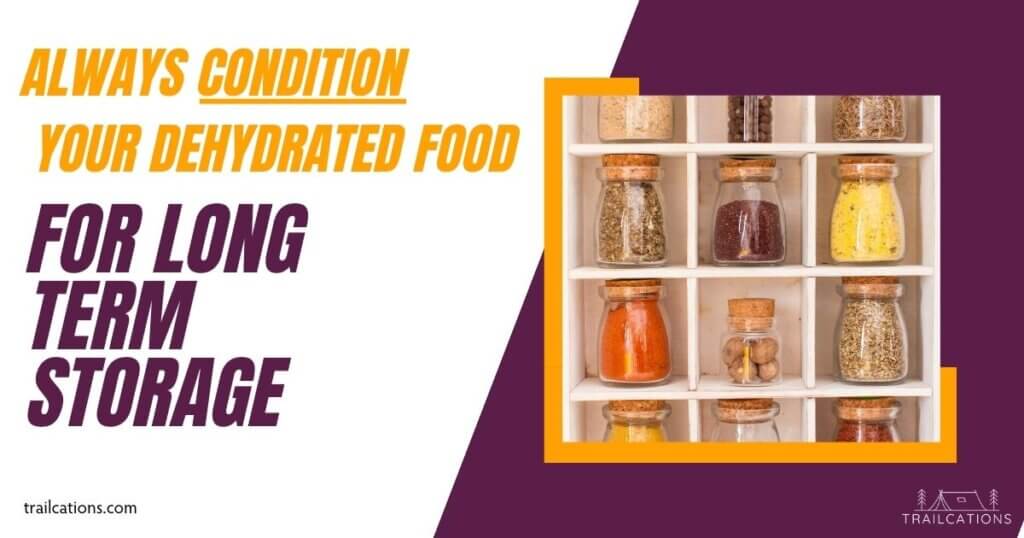
Conditioning Foods: Don’t Skip This Step!
When dried food is taken from the dehydrator, the remaining moisture may not be evenly distributed because of food thickness or position in relation to the fan. Conditioning is a final quality check that equalizes the moisture in an entire batch of dehydrated food and reduces the risk of bad bacteria and mold growth.
After dehydrating and testing food for doneness using sight, sound and feel tests, allow food to cool for 30 to 60 minutes. Any longer and you risk ambient humidity to be reabsorbed into your food. However, packaging food while it’s still warm can cause sweating and moisture buildup.
To condition foods, you typically take fruits and vegetables that have cooled and pack them into an airtight glass jar or plastic container. Clear containers are best. Seal the containers and let stand for up to 7 days, checking the food daily for moisture condensation and shaking the jars to separate the pieces.
If you spot condensation, immediately return the food to the dehydrator for several hours to continue drying. Recondition the food, package and store in a cool, dark, dry place. However, if there are signs of spoilage like bad smells, mold spots or bacteria growth, you need to throw the entire batch of food away. At that point, there is no recovering the spoiled food and you risk becoming sick if you consume it.
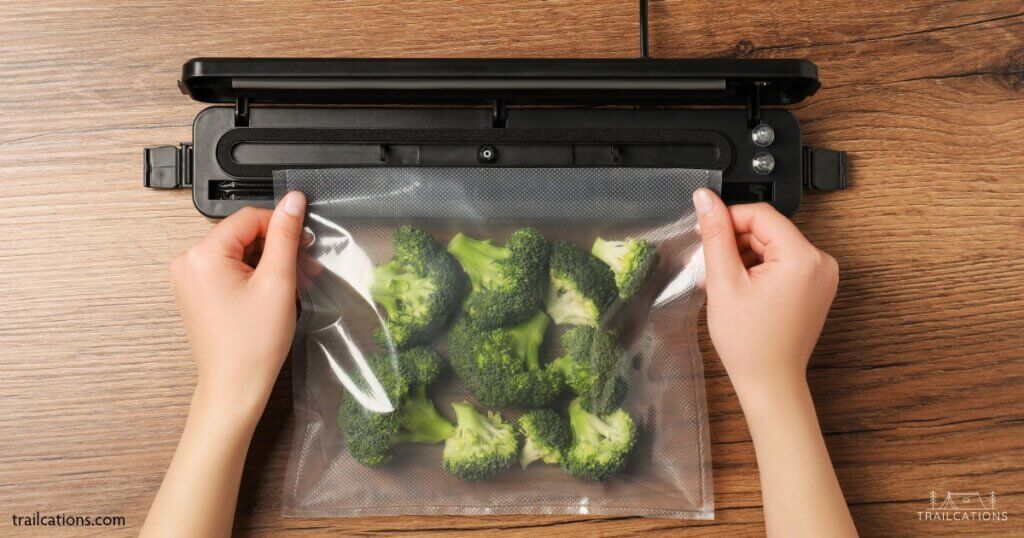
How To Vacuum Seal Dehydrated Food?
To vacuum seal dehydrated food, you can follow these general steps:
1. Dehydrate and cool the food: Make sure the food is completely cool and dry before vacuum sealing it.
2. Choose a bag: Choose a vacuum-seal bag that is large enough to hold the food and has a textured or embossed surface to help remove air. It is better to choose a larger bag to allow for food to shift around.
3. Fill the bag: Fill the bag with the dehydrated food, leaving enough space at the top for sealing. Add an oxygen absorbing packet at this point if you have one.
4. Vacuum seal the bag: Place the open end of the bag into the vacuum sealer and close the lid. Press the vacuum and seal button to remove the air and seal the bag.
5. Store the bag: Label the bag with the contents, dehydration date and estimated expiration date (we use the USDA Food Keeper guidelines). Store the bag in a cool, dry and dark place. For extra protection from pests and UV light, store vacuum sealed bags in a hard-sided container like a 5 gallon bucket, cooler or food grade bucket.
Although vacuum sealing can help extend the shelf life of dehydrated food, it’s still important to properly store the bags in a cool, dry, and dark place to prevent spoilage. It’s also important to check the bags periodically for signs of moisture or spoilage.
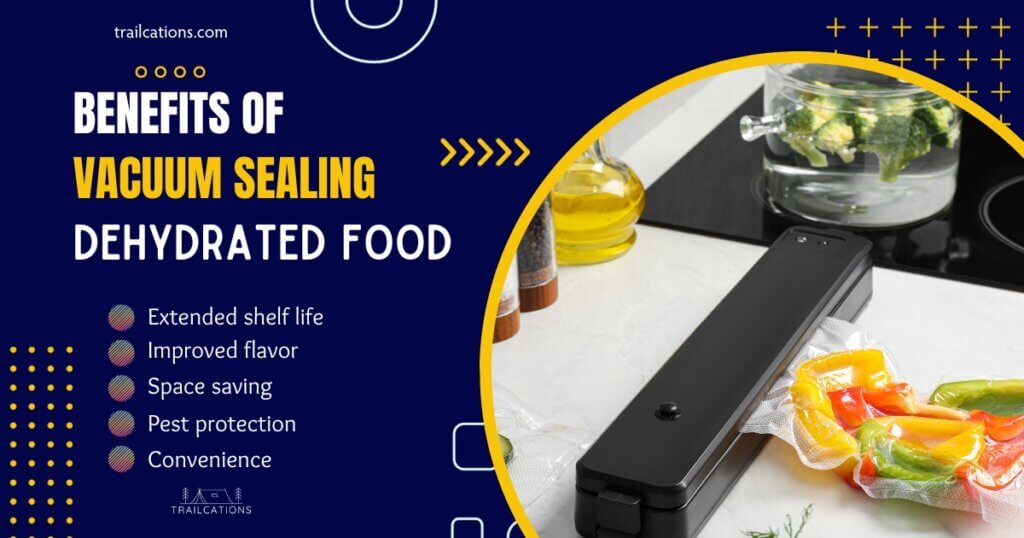
Benefits of Vacuum Sealing Dehydrated Food
Vacuum sealing dehydrated food offers several benefits, including:
- Extended shelf life:Vacuum sealing removes air and moisture from the bag, which helps to prevent spoilage and extend the shelf life of the food.
- Improved flavor:Vacuum sealing helps to preserve the flavor of the food by preventing exposure to air, which can cause oxidation and off-flavors.
- Space saving:Vacuum-sealed bags take up less space than other storage methods, such as jars or containers, making them a convenient option for storing dehydrated food.
- Protection from pests:Vacuum sealing helps to protect the food from pests such as insects, which can be attracted to food stored in open containers.
- Convenience: Vacuum-sealed bags are easy to store and transport, making them a convenient option for camping, hiking, or other outdoor activities.
Overall, vacuum sealing dehydrated food can help to preserve its quality and extend its shelf life, while also providing a convenient and space-saving storage option.
How Long Does Vacuum Sealed Dehydrated Food Last?
Vacuum sealed dehydrated food tends to last towards the longer end of the shelf life range recommended by the USDA. The reason vacuum sealed food can be preserved longer is due to the removal of almost all of the oxygen and the impermeable nature of vacuum seal bags, containers and mylar packaging. Oxygen is quick to destroy nutrients, vitamins and minerals in dehydrated food.
Some dehydrating enthusiasts suggest that vacuum sealed dehydrated food can last years or even decades. However, it has been shown that after a year in storage the rate of nutrient loss speeds up in dehydrated food. To maximize shelf life, freeze dehydrated food in a freezer safe vapor barrier container or bag.
We’ve had decent success with our home dehydrated vacuum sealed food lasting 1 to 2 years stored at about 60°F (15°C) but some of the textures, flavors and appearances can change slightly. This article by Chef Glenn of Backpacking Chef fame is an interesting read on what happens to vacuum sealed dehydrated food after 2 years.
Besides losing nutrients after 1 year of storage, dehydrated food starts to change appearance. Vacuum sealed mylar bags may be your best choice to reduce oxygen, moisture and light exposure and increase the shelf life of your vacuum sealed food.
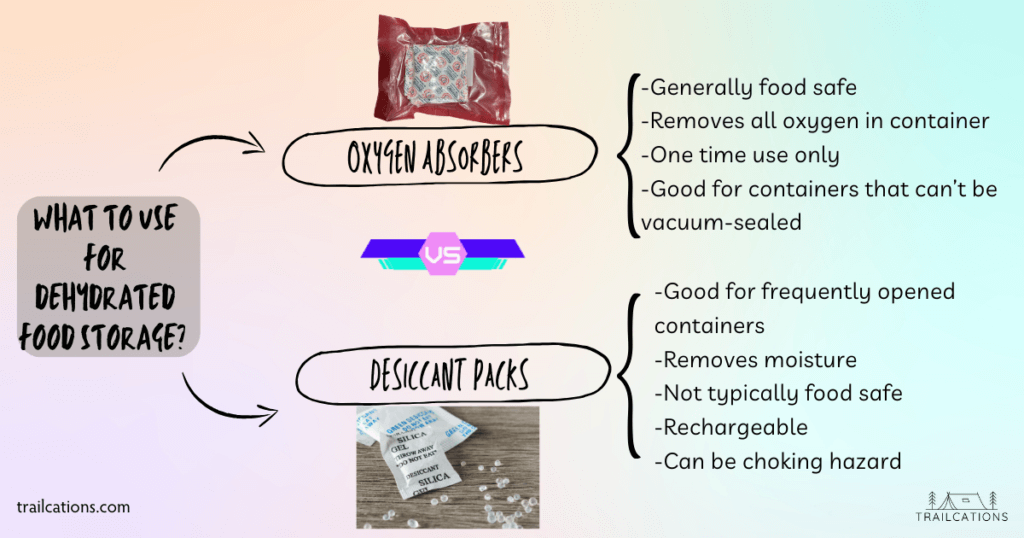
Oxygen Absorbers vs. Desiccant Packs (Silica Gel / Silica Bead Packets)
Keep in mind that oxygen absorbers and desiccant packs are NOT necessary for dehydrating and storing food for short term use. Oxygen absorbers are only necessary when you cannot vacuum seal food but need to store it long term.
Never use oxygen absorbers with desiccant packs. Oxygen absorbers need moisture to work properly whereas desiccant packs absorb moisture, making using them together counterproductive.
Desiccant Packs (aka Moisture Absorbers, Silica Gel Packs, Silica Bead Packets)
Desiccant packs are also known as moisture absorbers, silica gel packets or silica bead packets. They are all composed of some type of material made from silica that absorbs moisture. Generally, desiccant packs are not food-safe and can be found in commercial items like shoes, handbags and electronics.
Pros:
- Controls moisture levels in containers that are frequently opened.
- Can be recharged by putting in dehydrator or oven for a few hours.
- Reduces moisture in dehydrated food containers that have excess space.
Cons:
- Choking hazard, especially for small children.
- Not usually food safe
What Size Food-Safe Desiccant (Moisture Absorber) Pack to Use?
- Use a 0.5 g moisture absorber for an 8 oz (237 mL) jar.
- Use a 1 g moisture absorber for a 16 oz (473 mL) jar.
- Use a 2 g moisture absorber for a 32 oz (967 mL) jar.
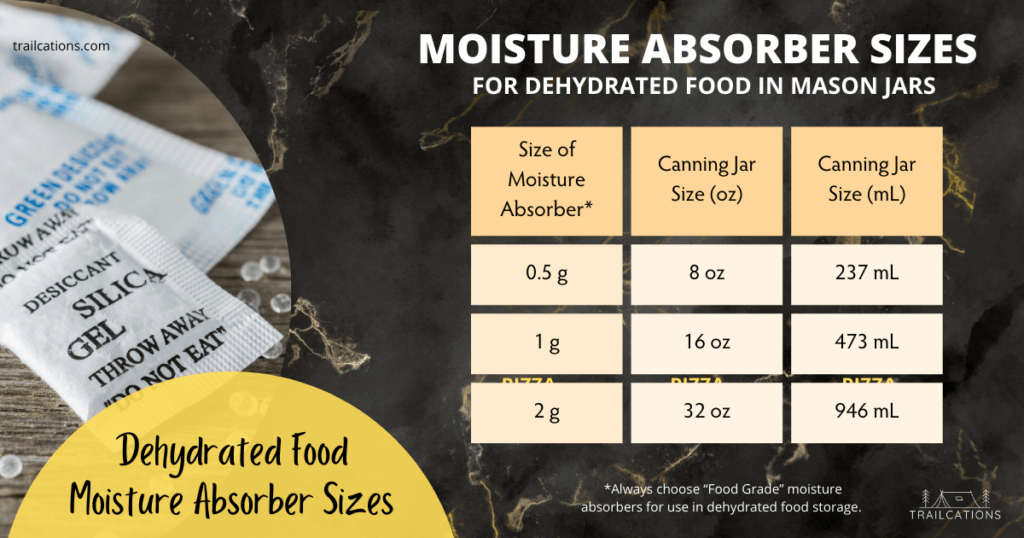
What is the Best Moisture Absorber for Food Storage?
There are several types of moisture absorbers that are suitable for food storage, including:
- Silica gel packets: Silica gel packets are a popular choice for food storage because they are effective at absorbing moisture and are safe for food. They come in various sizes and can be placed in food storage containers or bags.
- Calcium chloride: Calcium chloride is another type of moisture absorber that is effective at reducing humidity and preventing moisture buildup in food storage containers. It’s also safe for food and can be found in various forms, such as pellets or crystals.
- Activated charcoal: Activated charcoal is a natural moisture absorber. It can help to prevent mold and bacteria growth in food storage containers. It’s also safe for food and can be found in various forms, such as pellets or powder.
Ultimately, the best moisture absorber for food storage will depend on your specific needs and preferences. Silica gel packets are a popular and effective choice, but it’s important to make sure that the packets are labeled as safe for food use.
Oxygen Absorbers (aka O2 Absorbers)
Oxygen absorbers use iron pellets to remove oxygen from a container. These are excellent options for long term dehydrated food storage. However, they do not control moisture levels and are one-time use only. If exposed to the air for a few minutes, they become useless so they’re not appropriate to use in containers that are frequently opened. These are best used for long-term storage of dehydrated food. Examples of these absorbers can be found in commercial beef jerky.
Pros:
- Reduces oxygen levels in containers that cannot be vacuum sealed. This includes food-grade buckets or versions of large jars and certain mylar bags that cannot be vacuum sealed.
- Controls oxygen in containers with lot of space. Ensures all the oxygen is removed.
- Are available in many food safe and food grade sizes, options and pack quantities.
Cons:
- Ruined if exposed to air for a few seconds to a few minutes. Be prepared to use these quickly and store the rest in an airtight container immediately.
- Not reusable or rechargeable.
- Not good to use with fatty (ex: nuts, seeds, granola) or high moisture foods (partially dried fruits).
- Bad for use in containers that are not airtight like ziploc bags.
- No food-safe DIY option to make your own. Steel wool DIY options are not typically food safe due to the manufacturing process.
What size oxygen absorber to use?
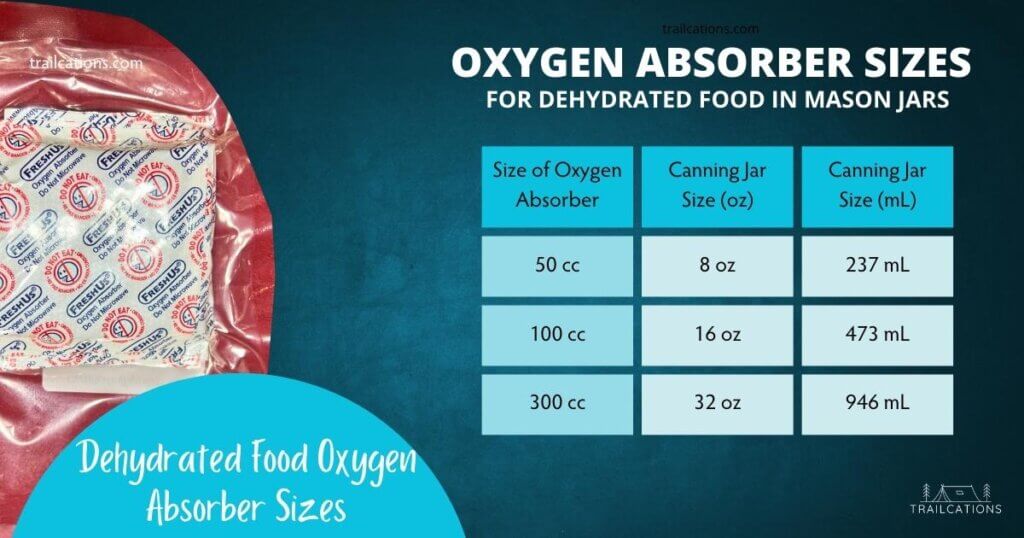
First, make sure you use the smallest size jar that will hold your dehydrated food. The more space taken up by food means there’s less oxygen to remove in the jar.
Next, choose the appropriate size oxygen absorber. These typically only cost a few pennies per absorber.
- Use a 50 cc oxygen absorber for 8 oz (237 mL) jars.
- Use a 100 cc oxygen absorber for 16 oz (473 mL) jars.
- Use a 300 cc oxygen absorber for 32 oz (967 mL) jars.
If you only have one size oxygen absorber, use 2 or 3 of them for larger jars.
Once you open up a pack of oxygen absorbers, take out what you need for immediate use. Transfer the rest of the oxygen absorbers to an airtight bag or jar.
Many oxygen absorbers come with a color-changing sticker that shows when they have been exposed to too much oxygen. The sticker changes color when overexposed to oxygen and indicates the absorber has been rendered useless. After wasting quite a lot of oxygen absorbers from being too slow in storing them, I now try to only purchase oxygen absorbers that have been bagged in small bundles like 5 to a pack.
Do I Need to Use Oxygen Absorbers?
No, you don’t need to use oxygen absorbers for dehydrated food! If you have properly dried, conditioned and stored your ingredients, oxygen absorbers aren’t necessary. Vacuum sealing works just as well for maximizing dehydrated food shelf life.
Are oxygen absorbers helpful? Absolutely! They help ensure that any residual bits of nutrient-degrading oxygen left in your airtight container are removed from your food. However, don’t let a lack of equipment prevent you from dehydrating and storing as much dried food as you like. For many years when money was tight, we stored dehydrated food without using oxygen absorbers.
Alternatives to Oxygen Absorbers
The best alternatives to oxygen absorbers is vacuum sealing your food. While vacuum sealing doesn’t remove 100% of the oxygen in your jar, it removes most of it, making it good enough for long term storage of dehydrated food for a year or so.

How Do You Keep Dehydrated Food Dry?
To keep dehydrated food dry, crispy and fresh, it’s important to store it in airtight containers that prevent moisture from getting in. Using containers like mason jars or vacuum-sealed bags can help maintain the dryness and freshness of the food.
Additionally, storing the dehydrated food in a cool, dark, dry place away from direct sunlight. Keep food away from sources of humidity such as pipes or on the floor to prevent any moisture absorption.
Proper storage techniques can also help remove any excess moisture and keep the dehydrated food dry. Maximize shelf life by using oxygen absorbers and conditioning food before long term storage.
Vacuum sealing also helps to keep dehydrated food crispy, dry and fresh in the long term. Occasionally check on your vacuum sealed jars to ensure the seals haven’t leaked. Also check that your vacuum sealed bags to make sure food hasn’t poked through and lost the seal.
Can Food Spoil While Dehydrating?
Yes, food can spoil while dehydrating if it is not properly prepared or dehydrated at the correct temperature and time. According to the National Center for Home Food Preservation, it’s important to properly wash and prepare food before dehydrating. Research studies have shown that pretreating food with an acidic solution prior to dehydrating prevents harmful bacteria growth which can spoil the dried food.
Always follow the recommended temperature and time guidelines for the specific type of food being dehydrated. If the food is not dehydrated at the correct temperature or for the correct amount of time, microorganisms will grow. These yeasts, mold and bacteria can cause spoilage and food poisoning.
Additionally, if the dehydrator is not properly cleaned and maintained, it can also become a breeding ground for bacteria. It’s important to handle the food safely and to follow proper food safety guidelines to prevent spoilage and foodborne illness.
Check out our article on How to Clean and Store Your Food Dehydrator.
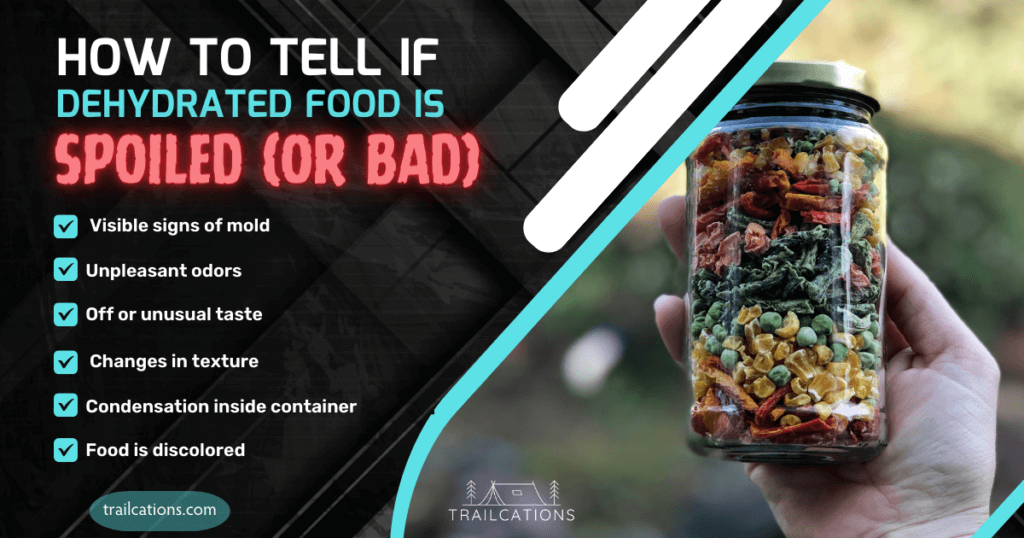
How To Tell If Dehydrated Food is Bad or Spoiled?
There are several ways to tell if dehydrated food has spoiled. Signs of spoilage in dehydrated food can include:
– Visible signs of mold or discoloration
– Unpleasant or unusual odors
– An off or unusual taste
– Changes in texture, such as becoming chewy or sticky
– Moisture or condensation inside the container
If you notice any of these signs, it’s best to err on the side of caution and discard the food. Always store dehydrated food in a cool, dry, dark place to prevent spoilage. Periodically check the containers for any signs of spoilage or moisture. Properly labeling the containers with the contents and date of dehydration can also be helpful in identifying any spoiled food.
Is Dehydrating Food Good for Long Term Storage?
Yes, dehydrating food is a good method for long term storage. Dehydrating food removes the moisture from the food. This helps prevent the growth of bacteria, yeast and mold which can cause spoilage and food poisoning. This makes dehydrated food less susceptible to spoilage and can help extend its shelf life.
Dehydrated food is also extremely lightweight. It takes up less space than fresh food, making it a convenient option for long term storage. Make sure to store the dehydrated food in a cool, dry, dark place to prevent moisture and light from getting in. Check the containers periodically for signs of spoilage or moisture.

What Foods Can Be Dehydrated for Long Term Storage?
If you’re wondering what specific foods are best for dehydrating for long term storage, choose low fat or nonfat. Dehydrate foods that are oil free and extremely low fat, especially for meats, fish and jerky. Foods that contain high amounts of oil or fats will quickly become rancid in long term storage. Oily dehydrated foods can easily become hosts to bad bacteria like salmonella or botulism.
For more details, check out our free PDF guide of 500 Foods You Can and Cannot Dehydrate.
Here are some general examples of dehydrated foods that are good for long term storage:
Fruits and Vegetables
Some fruits that dehydrate well include apples, bananas, strawberries, peaches, apple slices and apricots. For vegetables, try dehydrating carrots, peppers, onions, corn, peas, celery, greens and broccoli. Dehydrated fruits and vegetables make great snacks on their own or can be rehydrated and used in recipes. We’re currently obsessed with making dried zucchini, beet and sweet potatoes into veggie chips.
Meats, Fish and Jerky
If you’re a meat lover, try dehydrating lean beef, turkey, fish or chicken to make jerky. You can also add flavor by marinating the meat in an oil-free marinade before dehydrating. Jerky is a great high-protein snack to take with you on the go.
Snacks and Trail Mix
Dehydrated fruits and vegetables can be combined with nuts and seeds to make a healthy and delicious trail mix. You can also add in some dehydrated jerky for an extra protein boost.
Soups and Stews
Dehydrated vegetables can be rehydrated and used in soups, stews, and chili. You can also dehydrate cooked beans to add to your soup or chili mix. This is a great way to add some extra nutrition to your meals.
Fruit Leather and Granola
Dehydrated fruits can also be blended into a puree and spread out on a dehydrator sheet to make fruit leather. You can also dehydrate oats, nuts, and seeds to make granola but store high fat ingredients in the freezer or fridge instead of at room temperature to avoid spoilage. These are great options for a healthy and portable breakfast or snack.
Mushrooms
Dehydrated mushrooms are a great addition to add to meals like stews, risottos and noodle dishes. They can also be ground into powders to add extra flavor to sauces.
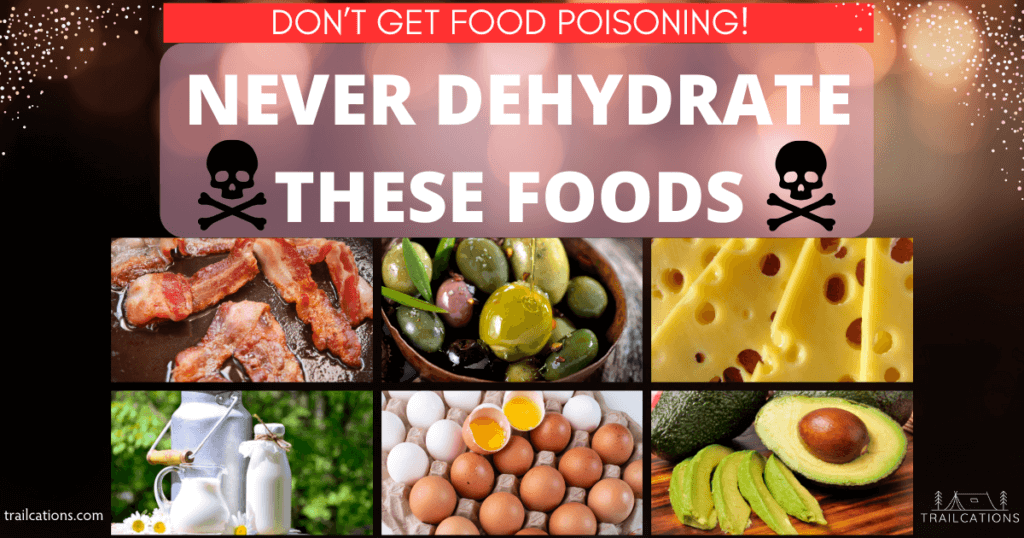
Is There Anything You Cannot Dehydrate?
Can all foods be dehydrated? What fruit can’t you dehydrate? Check out our super fun article (and free PDF!) of 500 Foods You Can and Cannot Dehydrate.
Unfortunately, all foods cannot be safely dehydrated at home for a variety of reasons. Any oily or fatty food cannot be safely dehydrated and/or placed in long term storage. Fats and oils quickly become rancid and spoil at room temperature storage.
The low-oxygen environment of oily dried foods can harbor dangerous, or even fatal, bacteria. These anaerobic bacteria, like botulism, can make you very sick or even kill you. Finally, the low and slow temperatures of dehydrating actually can increase growth of microorganisms that cause food poisoning. Instead, opt for commercially available freeze-dried or spray-dried foods. These preservation techniques are faster and safer than what can be achieved with a home dehydrator.
Some Foods You Cannot Safely Dehydrate for Long Term Storage
Fruits and Vegetables: Fruits and vegetables you can’t dehydrate include avocados and olives. Instead, purchase freeze-dried versions of these.
Eggs, Dairy Products and Oils: Never dehydrate eggs, dairy products, milks (even fat-free versions), butters, oils or cheese. Instead, save yourself the risk of food poisoning and purchase the affordable spray-dried and freeze-dried versions of these ingredients.
Nuts and Seeds: Store dehydrated nuts and seeds in the freezer or refrigerator. Their high oil content will spoil and become rancid if left at room temperature long term. Nut butters and nut milks shouldn’t be dehydrated – instead buy commercially freeze dried or spray dried powders.
Fatty Meats and Oily Fish: Never dehydrate any meat with a fat content of 10% or more. This includes fatty cuts of meat like ribeye, 85:15 ground beef/turkey, bacon, sausage and pork belly. It also means certain types of animals with naturally fatty meat shouldn’t be dehydrated. Avoid dehydrating goose, pig, lamb, quail and many “dark meat” poultry. Having gotten severe food poisoning from consuming home dried fatty meat, I cannot recommended enough to follow this rule.
Oily fish with more than 5% fat content should also not be home dehydrated (Excalibur). This includes salmon, tuna, mackerel and rainbow trout. Instead, opt for dehydrating low fat fish and seafood at home.
For a super fun, super free, hand-illustrated PDF guide, check out 500 Foods You Can and Cannot Dehydrate.
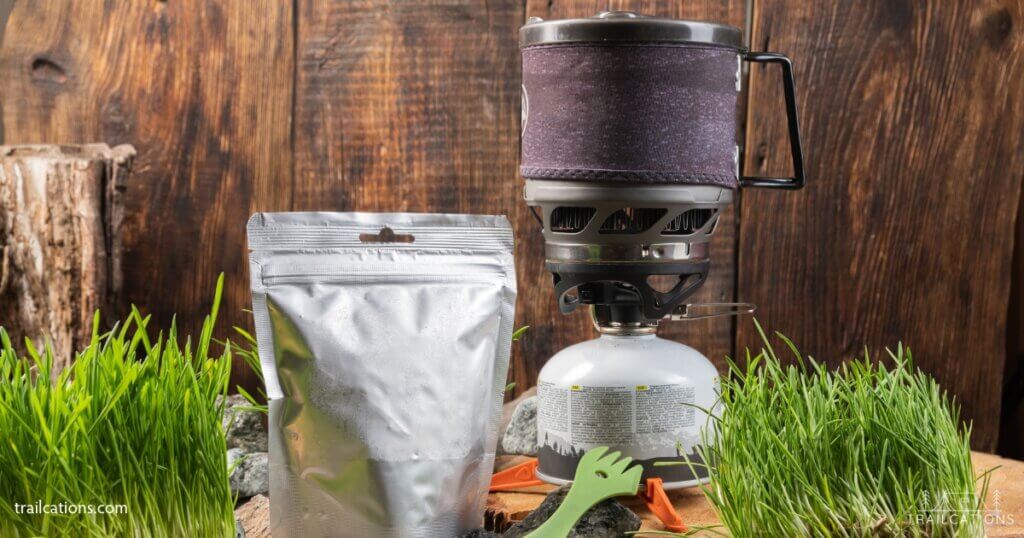
What Dried Food Lasts the Longest
The general rule of “less moisture = more time” applies to dried food. Commercial dried goods with preservatives last longer than home dehydrated versions. Dried foods with little moisture like dried grains, peas, beans, rice and pasta can last for many years. Some companies claim these foods can even last decades stored in airtight containers.
Honey will last indefinitely because it has almost no moisture and high sugar content. In fact, in 2015 archaeologists in Egypt tried 3,000-year-old honey with no ill effects. Reportedly it still tasted quite good! However, we don’t typically recommend consuming dehydrated food beyond modern food safety recommendations from the USDA. 😉
FAQs
How Do You Store Dehydrated Camping Food?
Just like other dehydrated foods, you should store dehydrated camping food at home in airtight containers. To prolong shelf life, always store dehydrated food in a cool, dark, dry place far away from direct sunlight.
At camp, store dehydrated foods in a hard-sided container like a food locker or out of sight in a car. Store food whenever someone over the age 18 isn’t within 100 ft (30m) of it. Many front country campgrounds provide food lockers to place dehydrated camping food and scented hygiene items. Alternatively, food can be stored in a bear canister or hung from a tree.
In bear country, store dehydrated foods in a certified bear-resistant container like a bear canister or food locker. Alternatively, hang food bags in a tree at least 10 ft (3m) from the ground and 4 ft (1.2m) from the trunk. The tree should be at least 150 ft (50m) from camp. Always follow local regulations about food storage to prevent animal encounters.
How To Preserve Dehydrated Food Without a Food Saver or Vacuum Sealer?
There are several ways to preserve dehydrated food without a vacuum sealer. Here are some methods:
1. Oxygen absorbers: Place the dehydrated food in an airtight container, such as a mason jar. Seal the jar and add an oxygen absorber packet to the container. The packet will help remove any remaining oxygen and extend the shelf life of the food.
2. Mylar bags: Place the dehydrated food in a Mylar bag and add an oxygen absorber packet. Seal the bag with a hot iron or hair straightener. Make sure to remove as much air as possible before sealing.
3. Ziploc bags: Place the dehydrated food in a Ziploc bag and remove as much air as possible before sealing. You can use a straw to suck out any remaining air but avoid breathing out any moisture into the bag.
4. Glass jars: Place the dehydrated food in a clean, dry glass jar and seal with a tight-fitting lid. Store the jar in a cool, dark place.
It’s important to note that these methods may not be as effective as vacuum sealing. However, they can still help extend the shelf life of dehydrated food. It’s also important to properly label and date the containers. Store them in a cool, dry, and dark place to prevent spoilage.
Can You Vacuum Seal Dehydrated Food?
Yes, you can (and should!) vacuum seal dehydrated food. Vacuum sealing dehydrated food can help to extend its shelf life by removing air and moisture from the bag. This help to prevent spoilage due to oxygen exposure as well as preserve nutrients, appearance and quality of the food.
Vacuum-sealed bags are also a space-saving and convenient option for storing dehydrated food. It’s important to make sure that the dehydrated food is completely cool and dry before vacuum sealing it. Store the bags in a cool, dry, and dark place to prevent spoilage.
How Many Years is Dehydrated Food Good For?
The shelf life of dehydrated food can vary depending on several factors such as the type of food, the dehydration method, pretreatment, conditioning and the storage conditions. However, in general, dehydrated food can last for several months to several years if stored properly.
We like to use the USDA Food Keeper site for recommendations on home dehydrated food shelf life. However, we’ve eaten certain dehydrated foods far past the recommended USDA shelf life. Typically there is minimal effect to flavor, quality and texture.
Some storage container companies have seen storage life extended to many years or even decades of certain low moisture foods. When these foods are stored in vacuum-sealed Mylar bags with oxygen absorbers, shelf life may be extended.
With home dehydrated meats, fish and jerky, we’d suggest sticking to the USDA Food Keeper shelf life recommendations. Home dried meats do not typically contain as many bacteria-preventing preservatives as commercially dried meats. Store bought dried meats are required to have certain preservatives per FDA and USDA standards. Therefore, home dried meats have a much shorter shelf life than store-bought jerky, dried fish and meat.
How To Store Your Food Dehydrator?
To store your food dehydrator, it’s important to first unplug it and allow it to cool completely. Clean the dehydrator thoroughly, following the manufacturer’s instructions. This may involve disassembling the dehydrator and washing the dehydrator trays, screens, shelves and other parts with warm, soapy water.
Once the dehydrator is clean and dry, reassemble it. Store the appliance in a cool, dry, dark place, away from sunlight and moisture. Sunlight can warp the soft outer dehydrator plastic housing. Moisture can cause bad bacteria to grow on any residual food debris.
It’s important to store the dehydrator in a way that protects it from dust and debris. Place the dehydrator inside a storage container, manufacturer’s box or on a shelf with a cover. Properly storing your dehydrator can help extend its lifespan. It also ensures that your new favorite appliance is ready for use the next time you need it.
Check out our easy Step-by-Step Guide on How to Clean Your Food Dehydrator.
How To Rehydrate Dehydrated Food?
To rehydrate dehydrated food, you can follow these general steps:
1. Choose a container:
Pick a container that is large enough to hold the food and liquid, and that has a tight-fitting lid. When camping, you can use a camping pot and stove to boil the water to cook your dehydrated meal. If you’re not using a stove, some other options to rehydrate your dehydrated food are:
- Plastic zip top bag
- Plastic container with screw top lid (ex: empty Talenti gelato container, empty peanut butter jar)
- Bowl
- Tupperware
- Glass jar
2. Add water:
Fill the container with enough water to completely cover the food. You may want to add an extra inch or two of water. The food will soak up the water, so you want to make sure there is enough. Alternatively, if your recipe has a recommended amount of water, make sure to use that specific amount.
3. Let it sit:
Cover the container with a lid and let it sit. If the water was boiled, you may only need to wait 10 to 20 minutes. Rehydrating times depend on factors like elevation, food type and food thickness. If you’re going stoveless, you may need to let the food sit for several hours or overnight. Timing depends on the type of food and how dry it is. Food that rehydrates longer than 2 hours should be refrigerated to avoid contamination from bad bacteria, mold and yeast.
4. Drain excess water:
Once the food is fully rehydrated, drain any excess water or consume as “sauce” for maximum nutrient retention. You can use the leftover water as part of the liquid in preparing the food. Some studies show that vitamins such as niacin, riboflavin and thiamin can be lost if the rehydrating liquid isn’t consumed.
5. Use the food:
Use the rehydrated food in your recipe as you would fresh, frozen or canned food.
The exact rehydration time will depend on the type of food being rehydrated and how dry it is. Some foods may require boiling water or longer soaking times. It’s also important to store the rehydrated food properly if you don’t plan to use it immediately. The refrigerator or freezer are the best places to store leftover rehydrated food.
How to Store Dehydrated Food at Camp or in the Backcountry
To store dehydrated food at camp or in the backcountry, you should keep it in airtight containers or resealable bags. Store the food in a hard-sided bear canister, food storage locker or hung properly from a tree or food pole.
At camp, always store food in food lockers, out of sight in a vehicle or hung in a tree. It’s best to store food when someone over 18 years old is not within 100 ft (30 m) of camp. Many campsites require food to be stored in a certain way to prevent wildlife from accessing it.
Always follow local regulations to avoid your food getting taken by wildlife. Many animals spread deadly diseases like hantavirus or rabies. Wildlife can also bite, scratch, maul or even kill you and your family. Chipmunks, mice and squirrels can carry the plague and hantavirus. Raccoons and foxes carry rabies. Coyotes, wolves, wild pigs and wild dogs can maul you. Bears can (and will) hurt or even kill you when it comes to accessing human food.
Store the containers or bags in a cool, dry place away from direct sunlight. You can also use vacuum-sealed bags to further extend the shelf life of the food.
How to Store Dehydrated Food in Bear Country
In bear country, use an approved bear-resistant food storage container like a food locker or bear canister. If you’re in the backcountry, be sure to hang your food. If there is no food pole available, you’ll need to hang food in a tree. Hang food bags at least 10 feet off the ground and 4 feet away from the tree trunk. This will keep it out of reach of most bears.
Ursacks, and other “scent proof” bags are not approved as “bear-resistant” by the US Forest Service (USFS), Interagency Grizzly Bear Committee (IGBC) and US National Parks Service (US NPS). We have personally seen these ripped open by wildlife several times. We’ve seen bears, wild mini ponies (yes, you read that right), chipmunks and squirrels chew up Ursacks.
Conclusion
Congratulations! You are now an expert on storing dehydrated foods. By following the steps outlined in this article, you can ensure that your dehydrated foods remain fresh, nutritious, and flavorful for a long time.
Remember to use proper temperature and humidity control when storing your dehydrated foods. Use airtight containers such as mason jars or vacuum seal bags to prevent moisture and air from getting in. Label your containers with the date and contents to keep track of what you have stored.
Don’t forget to get creative with your dehydrated foods! Try making fruit leathers or adding dehydrated vegetables to your soups and stews. Dehydrating your garden harvest is a great way to preserve your produce and enjoy it all year round.
With these tips, you can enjoy the benefits of dehydrated foods for months or even years. Happy dehydrating and Happy Trailcations Y’all!
Sources
- (1) US Department of Agriculture Research Services Division, Composition of Foods – Handbook No. 8, Analysis Charts Table 2 – Nutrients In The Edible Portion Of One Pound Of Food
- ziploc.com/en/Sustainability-and-Safety
- Hahladakis JN 2018
- Zimmerman L 2021
- Yang CZ 2011
- https://www.nytimes.com/2018/12/28/well/eat/food-additives-banned-europe-united-states.html
- https://nchfp.uga.edu/how/dry.html#gsc.tab=0
- https://www.foodsafety.gov/keep-food-safe/foodkeeper-app
- https://www.food-safety.com/articles/6724-7-simple-rules-for-effective-and-hygienic-dry-goods-storage#:~:text=The%20temperature%20should%20be%20between,F%20(10%C2%B0C).
- https://extension.colostate.edu/topic-areas/nutrition-food-safety-health/drying-vegetables-9-308/
- https://nchfp.uga.edu/how/dry/csu_dry_fruits.pdf
- https://www.sciencedirect.com/topics/agricultural-and-biological-sciences/sodium-metabisulfite#:~:text=Sodium%20metabisulphite%20(SMBS)%2C%20the,on%20some%20people%2C%20especially%20asthmatics.
- https://extension.oregonstate.edu/ask-extension/featured/safety-tips-dehydrated-produce
- https://epacflexibles.com/15-foods-that-are-best-when-stored-in-mylar-bags/
- https://www.mylarshop.com/mylar-shop-articles/which-foods-can-you-store-in-mylar-bags